April 29
Breakfast on the veranda of our room. Ah, yes, it’s a tough life, but I know that somebody must live like this, and I’m prepared to do my part.
A footnote (pun intended) to yesterday’s blog. Walking along the beach with Rosa and Paul last night, we noticed some boys playing a game at a volleyball net. We assumed they were playing volleyball, but when we looked more closely, we noticed that they were getting the ball over the net using soccer rules, i.e. never touching the ball with their hands. It’s called foot volley, and is quite amazing to watch.
Picked up at 9 by our guide, Luiz, who had met us at the airport yesterday. A full day of traditional Rio sightseeing. At Corcovado and Sugar Loaf. After a scenic ride along the Rodrigo de Feitas Lagoon, we arrive at the Cosme Velho district, where we board a cog-train, which takes us right through the Tijuca Forest, to the top of Concovado (hunchback) mountain. On our way up, we enjoy beautiful views of the Guanabara Bay,the Rodrigo de Freitas Lagoon, the beach of Ipanema and Leblon and the Rio-Niteroi Bridge. Arriving at the base of the Statue of Christ the Redeemer, we have a stunning 360 degree view over the city. The statue was paid for, constructed and owned by the Catholic Church. Though it was intended to be completed for the centennial of independence in 1922, delays in raising funds and construction postponed its completion until 1931 (query whether the work planned for the World Cup and Olympics will meet a similar fate). The statue is almost 100 feet high, about the height of the Statue of Liberty, minus the torch, and the arm span of the statue is some ninety feet.
Carol, of course, had to feed a monkey a pistachio nut she had in her purse. Riding back down on the tram, we are entertained by some young Brazilian musicians, who are playing for tips and succeed in getting several of the women on the car to dance with them. Fun.
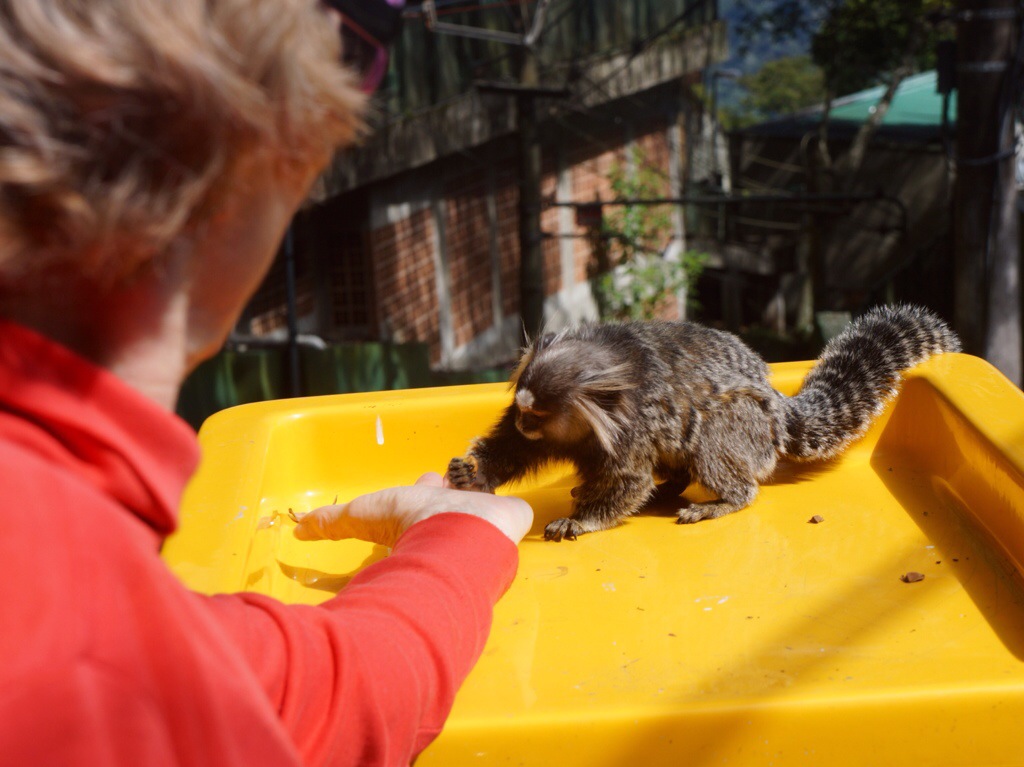
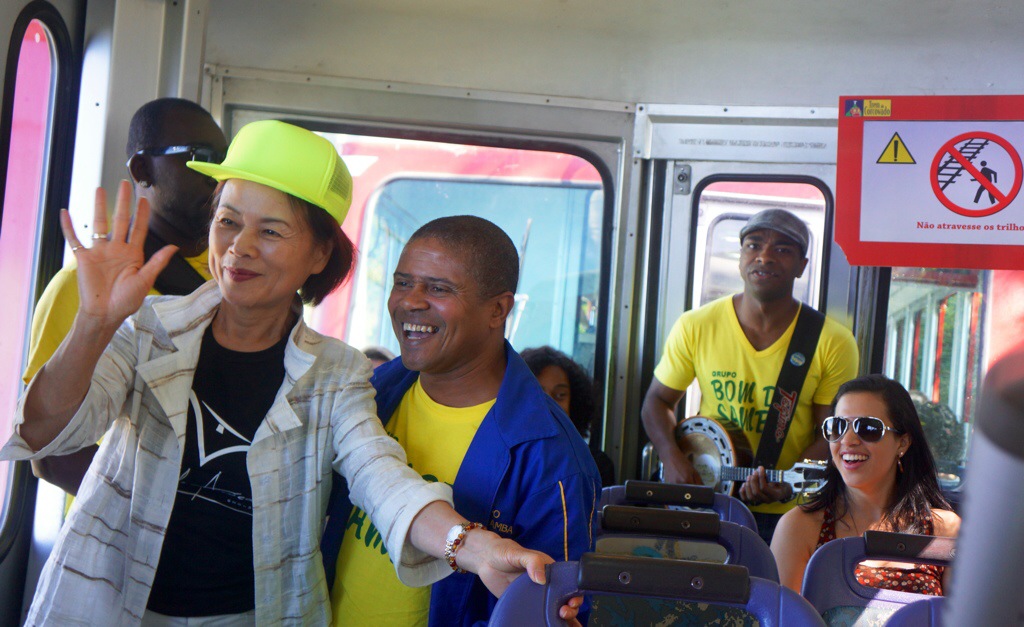
The afternoon involved taking two cable cars up to the top of Sugar Loaf, a mountain that looks back on the city of Rio and Concovado, rather than looking out from the city towards the bay, as we did this morning. Now, I know this sounds like a pretty boring day, and the photos below won’t do it justice, but it’s impossible to overstate how breathtaking the city of Rio is. Looking at it for a day was well worth the time.
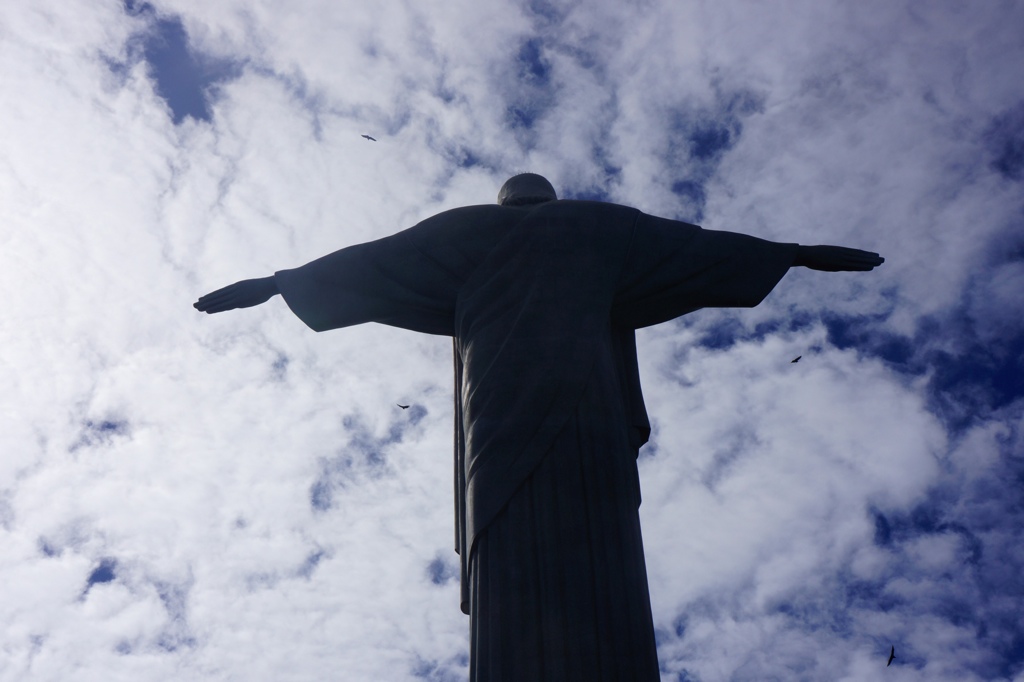
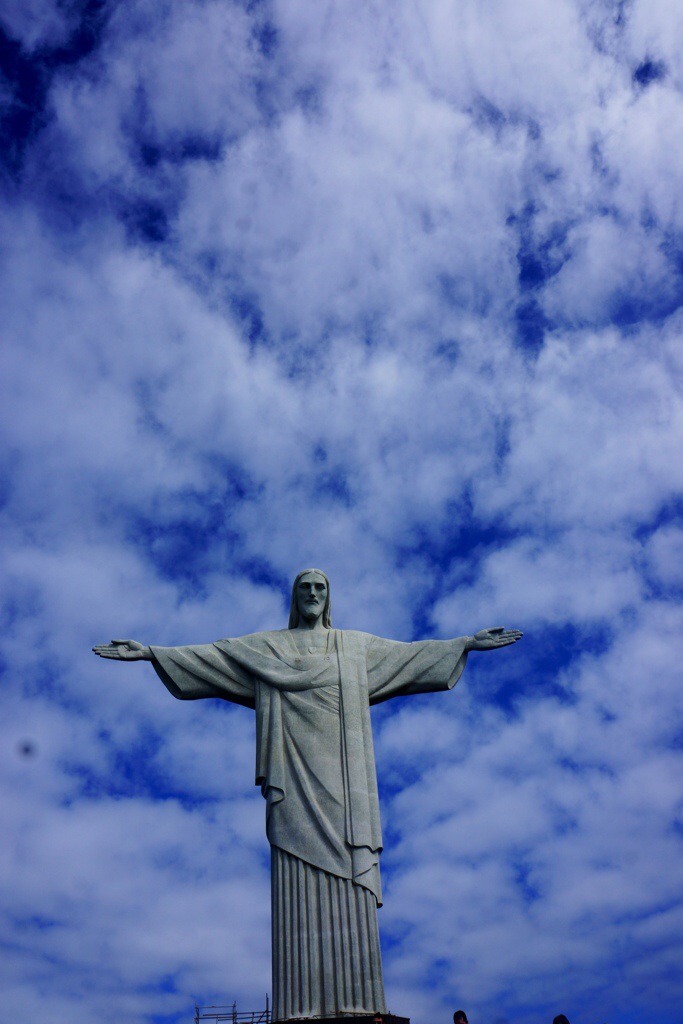

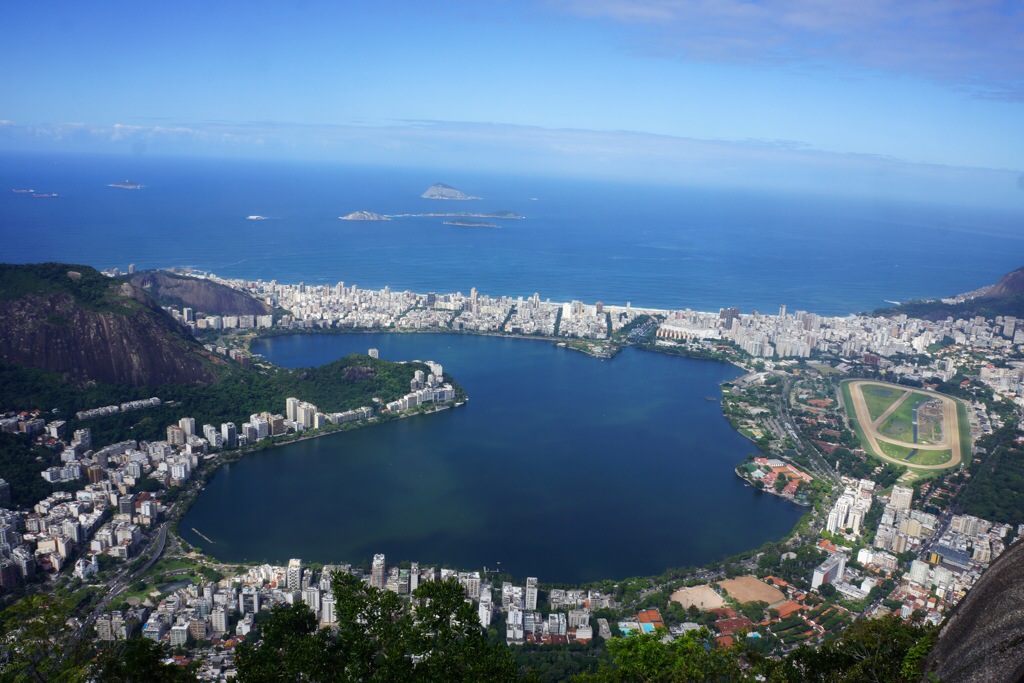 < <



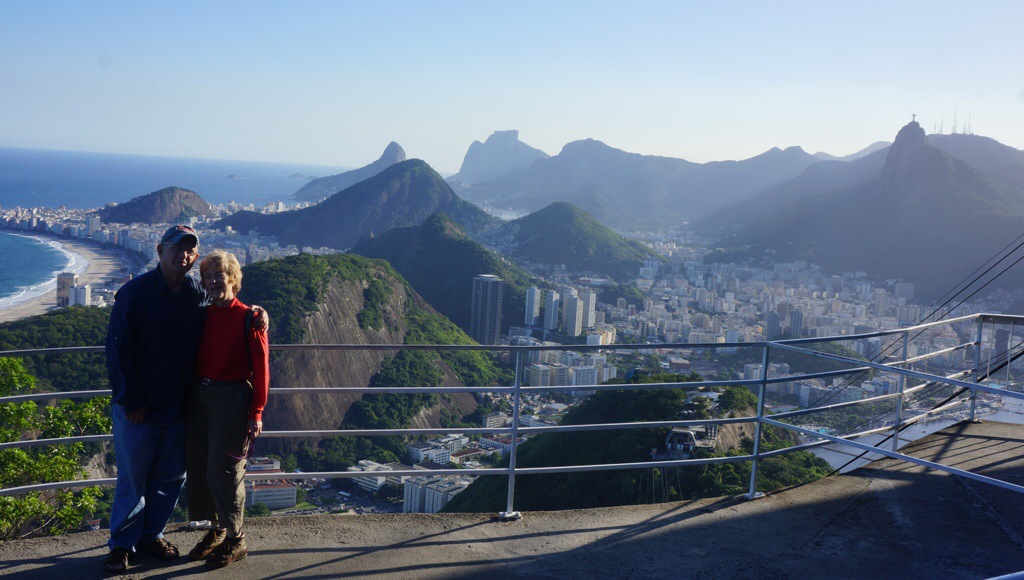
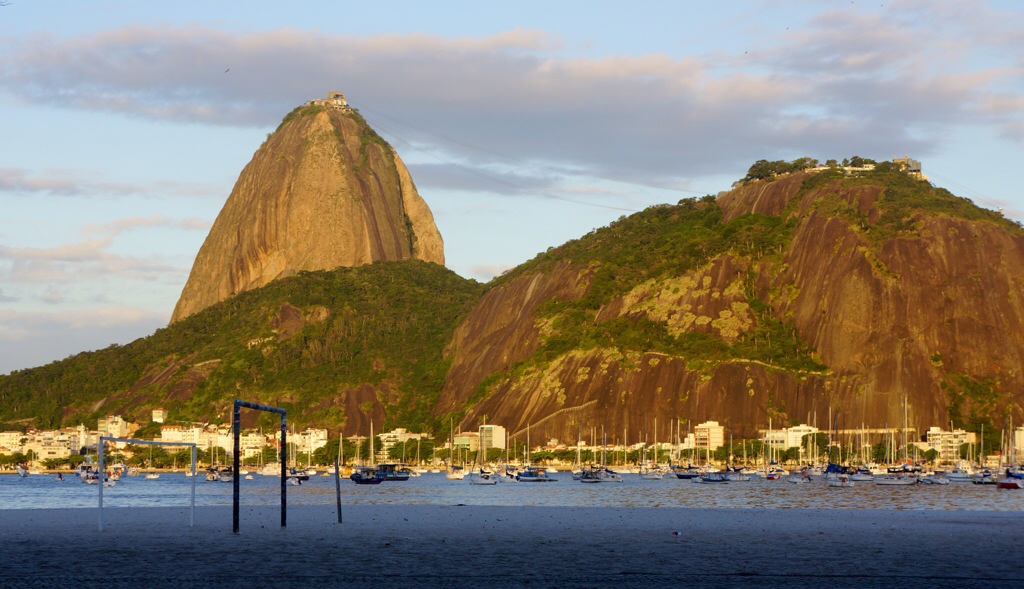
I lied a little bit, though, because we did do several other things, the most interesting of which was stopping at a museum of naïve art that has a collection of some 6000 items from all around the world, the collection of a Jewish jeweler. Wonderful to look at, and many of the pieces were extremely good. We also stopped for lunch at a Brazilian steakhouse in Ipanema, whose ample salad bar of seafood items more than satisfied Carol. And we ran three errands, two of which were successful (buying tickets for a modern dance concert at the opera house tomorrow night and getting cash at an ATM). The third, trying to find an orthopedic seat for Carol at two different places, was not.
Returned back to the hotel to rest. You’ve probably figured out by now that, for me, “rest” is a synonym for “blog”.
Took a taxi to D” Amici, a very good Italian restaurant in Copacabana, where we met Andrew Janszky, who heads up the Brazilian operation for a large New York firm, Milbank. I had gotten to know Andrew almost thirty years ago, when he was the hiring partner of Shearman & Sterling, a consulting client of mine. Andrew is based in San Paolo, but was able to arrange business in Rio, so that we could have dinner together. So, if anyone needs proof of the smallness of the world, in less than a week, Carol and I have had dinner with a Brazilian oncologist and his radiologist wife, a Brazilian cardiologist and her economist husband and a Brazilian/American lawyer.
Dinner with Andrew was terrific, once we finally found the place. The taxi driver could not find it and dropped us at a spot that was not our restaurant. After getting help from a couple people we found, who, luckily, spoke English we located the restaurant.
Andre (his real name, which he goes by in Brazil) is a lot of fun, lively, and we picked up pretty-much where we left off some twenty-five years ago. He has a unique perspective, having been born in Brazil of Hungarian parents, moved to and lived in NY, and now living half time in NY and half in Brazil. Andrew loves the Brazilian people but finds it frustrating to live with constant concerns about safety. I think it’s fair to say that he’s down on many aspects of Brazilian life, when compared to life in the U.S. After a delightful, long dinner with much conversation, Andrew sent us back to our hotel with the driver he uses in Rio.
April 28
After finishing our packing, on which we’d gotten a good start last night, we enjoyed another good breakfast at the hotel. Picked up by Gabriela and our driver at 8:30 and arrived at the airport two hours ahead of time for our 11:15 flight. We’re sitting here in a modern, but not very well air conditioned, airport. I ask Carol whether she thinks there’s early boarding available for people who are impatient. She says I can try.
Some reflections on our time in Salvador. It was not what we expected. We’d gone there because of the strong African influence and, while we understand that and saw and heard some of it, we did not really feel it the way we’d anticipated. Part of this may have been the poor timing for seeing the Candomble religion in action. Undoubtedly, too, our experience was colored by Carol’s necklace having been stolen, after which we were constantly on the watch. Gabriela and others warned me about my camera, so I wore it around my neck and kept a tight grip on it.
On the other hand, one can argue that this adverse experience was a dose of the reality of Brazil. And there certainly were aspects of our days here that were great–meeting Rodrigo and Fernanda, the Calafeta social project, the ballet folklorico, traversing the streets of the Pelourinho in the pouring rain with Gabriela, some very good food, the church experiences–so it was far from a total loss. The Pelourinho area holds considerable charm, but also a certain unreality. Rodrigo told us that, while Fernanda had lived in Salvador her whole life, she’d really only been to the area (other than to eat at some good restaurants) two times. So staying where we did was probably not experiencing the real Salvador.
Now for a bit of information I’ve stolen from various sources about Rio. First of all, so that you’ll really feel in the know, Rio is pronounce Hee-o. You can be obnoxious, as I’ll almost certainly be, and correct folks next time they show their ignorance by mispronouncing it. (Just as I assume you correct people when they mispronounce the Spanish city of Barthelona.)
.
Rio is the capital city of the State of Rio de Janeiro, the second largest city of Brazil, and the third largest metropolitan area and agglomeration in South America. There are approximately 6.3 million people living within the city proper, making it the 6th largest in the Americas and 26th in the world. It is the only state to be bordered by all the other states in the same macroregion. These are Minas Gerais, Espírito Santo and São Paulo. It is also bordered by the Atlantic Ocean. This state has a total area of 43 653 square kilometres.
Although originally inhabited by native tribes, Rio de Janeiro is considered to have been ‘discovered’ when Portuguese explorers encountered Guanabara Bay on 1 January 1502. The name Rio de Janeiro means “River of January”, and is based upon finding this destination on this date. It would be some 53 years later that one of the islands of Guanabara Bay was colonized and occupied by 500 French settlers. Today, this island is known as Villegagnon Island. Then, on 1 March 1565, the Portuguese established the city of São Sebastião do Rio de Janeiro, while Guanabara Bay was called Rio de Janeiro.
During the 1600’s, Rio became a convenient port for the transport of gold and precious stones. For this reason, the colonial administration was moved to the area in 1763 from Salvador. In 1808, the city saw an influx of Portuguese royal family and associated Lisbon nobles, who were escaping the Napoleonic invasion in their homeland. These Portugese ousted those who were occupying homes and territory within Rio to take over their established abodes. With these noblemen and royals came hundreds of thousands of slaves, who crossed the ocean from Africa. In 1808, when the Portuguese Royal Court transferred itself from Portugal to Brazil, Rio de Janeiro became the chosen seat of the court of Queen Maria I of Portugal, who subsequently, in 1815, under the leadership of her son, the Prince Regent, and future King João VI of Portugal, raised Brazil to the dignity of a kingdom, within the United Kingdom of Portugal, Brazil, and Algarves. Rio stayed the capital of the monarchy until 1822, when the War of Brazilian Independence began. It subsequently served as the capital of the independent monarchy, the Empire of Brazil, until 1889, and then the capital of a republican Brazil until 1960.
Rio de Janeiro represents the second largest GDP in the country (and 30th largest in the world in 2008), estimated at nearly US$201 billion, and is headquarters to two of Brazil’s major companies—Petrobras and Vale, and major oil companies and telephony in Brazil, besides the largest conglomerate of media and communications companies in Latin America, the Globo Organizations. The home of many universities and institutes, it is the second largest center of research and development in Brazil, accounting for 17% of national scientific production—according to 2005 data.
Rio is one of the most visited cities in the southern hemisphere and is known for its natural settings, carnival celebrations, samba, Bossa Nova, balneario beaches such as Barra da Tijuca, Copacabana, Ipanema, and Leblon. Some of the most famous landmarks in addition to the beaches include the giant statue of Christ the Redeemer (“Cristo Redentor”) atop Corcovado mountain, named one of the New Seven Wonders of the World; Sugarloaf mountain (Pão de Açúcar) with its cable car; the Sambódromo, a permanent grandstand-lined parade avenue which is used during Carnival; and Maracanã Stadium, one of the world’s largest football stadiums.
Rio will be one of the official Host Cities of the 2014 FIFA World Cup, and its Maracanã Stadium, which held the final of the 1950 FIFA World Cup and 2013 FIFA Confederations Cup, will host the final match of the 2014 FIFA World Cup. In 2016, Rio de Janeiro will host the Summer Olympics and the Summer Paralympics for the first time a South American and Portuguese-speaking nation will be hosting the event. It will be only the third time the Olympics will be held in a Southern Hemisphere city.
We’re about an hour late. Rio looks beautiful, mountains on one side, water on the other. A tremendous amount of work is being done, some of it in preparation for the World Cup, and major stuff in preparation for the Olympics. The old waterfront is being completely rebuilt and roads moved, so that we are routed through the downtown area to get to Santa Teresa, where our hotel/guest house is located. Fortunately, the tour I’d thought we were doing this afternoon had been switched to another day, as we would not have had time to do it.
We are staying at the Mama Ruisa, a colonial-style hotel located in Santa Teresa overlooking the Bay of Botafogo, 30 minutes from the airport, 15 minutes from Copacabana and Ipanema, and 10 minutes from the historic centre. The French-run property has only seven rooms, all with exclusive decoration, and serves breakfast on the verandah overlooking the bay. Okay, so that’s the stock description of the place, but doesn’t come close to describing how lovely it is. Gorgeous, huge room with bath, shower and walk-in closet, spacious living room with great art work, fabulous views, pool and garden area, wifi. (The photos below won’t do it justice, either.). We may never leave this place.
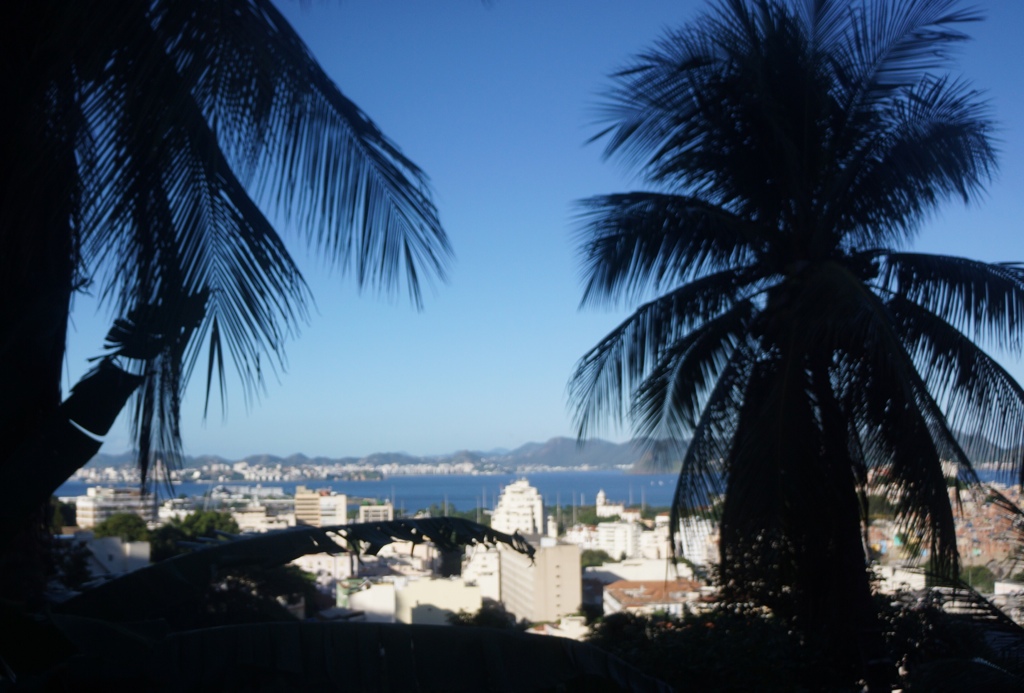
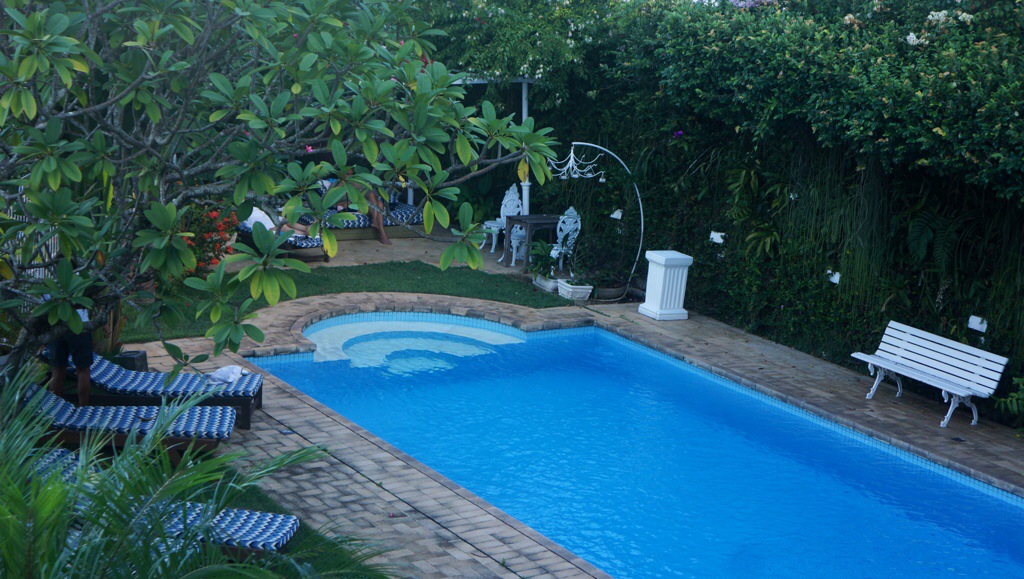
We took a walk up the hill from our guest house to the main street, which feels funky and a little Bohemian. There are a number of small restaurants, bars, arty stores, etc. As was true in Salvador, murals line many streets, though they appear to be less polished, if that’s a word that applies to graffiti, than many we saw in Havana.
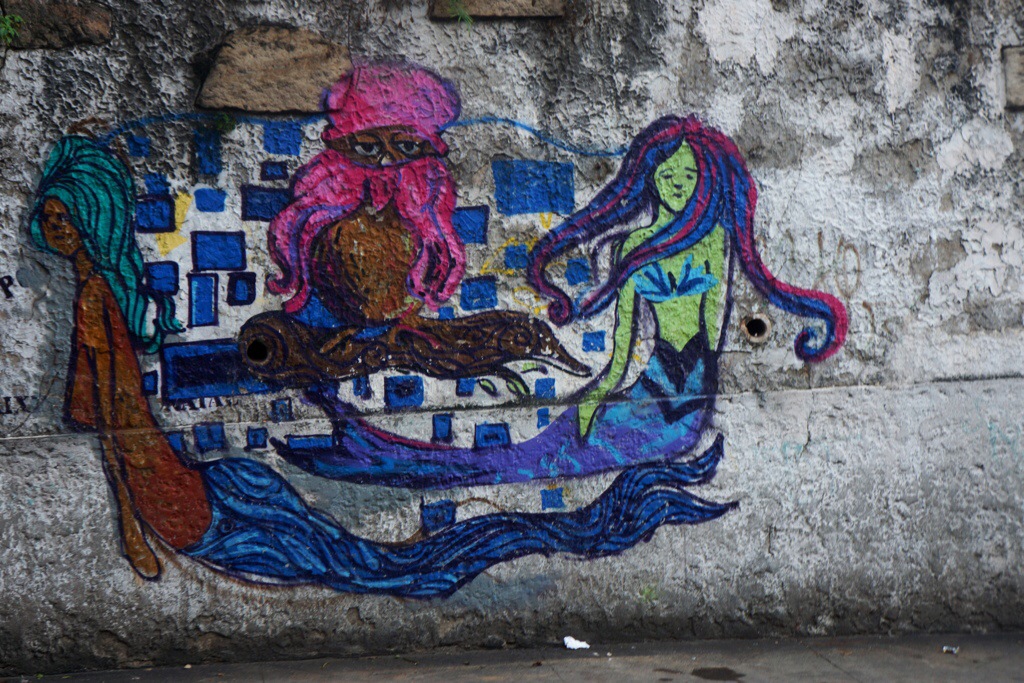
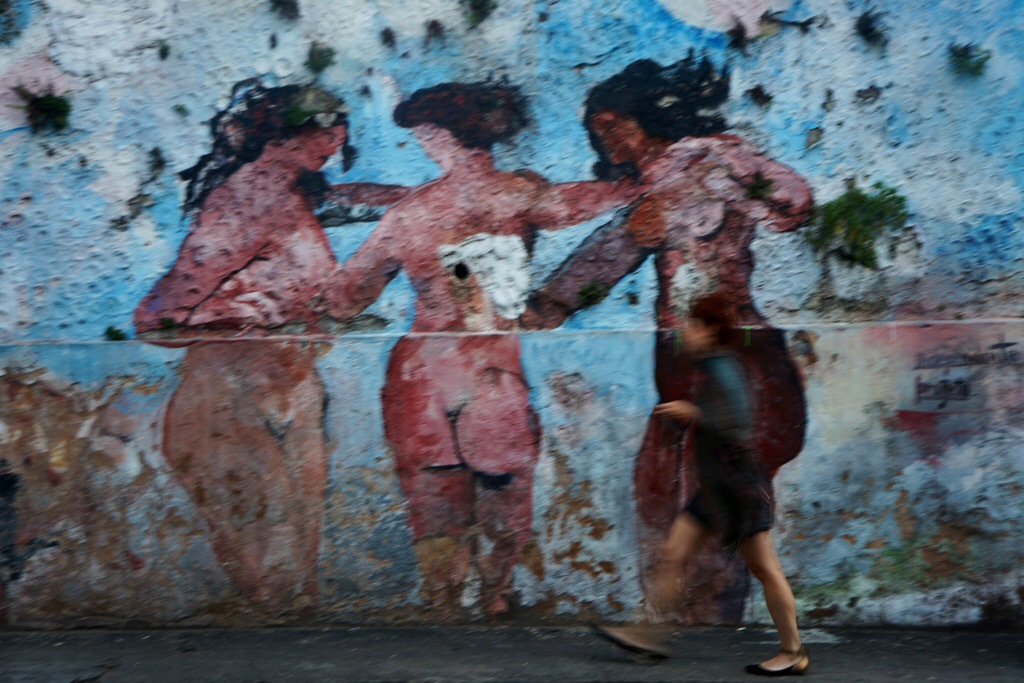
We wound up stopping for a small snack at what turned out to be a movie theater. There we had a long conversation with a young European woman who is building a house in Santa Teresa, but whose 7-year old daughter is in Italy with her husband. She’d lived in London and other places, and spoke articulately about the shortcomings of Brazil, including infrastructure, education, corruption, health. She described it as chaotic, but, at the same time, clearly has a love for the country.
Returned home and made arrangements to have dinner with Rosa (more below) and cleaned up and rested a bit. We met for dinner with a pediatric cardiologist who is a good friend of our close friend, Mike Freed. Rosa Barbosa took a 6 month sabbatical in Boston, where Mike is a pediatric cardiologist at Children’s. Rosa has set up a foundation and a cardiac hospital to take care of indigent children with congenital heart disease in Rio. Great time with Rosa and her husband, Paul, who is a retired economist. Rosa’s dedication and drive for the work she does is amazing. Her diminutive size notwithstanding, one underestimates her at their own peril.
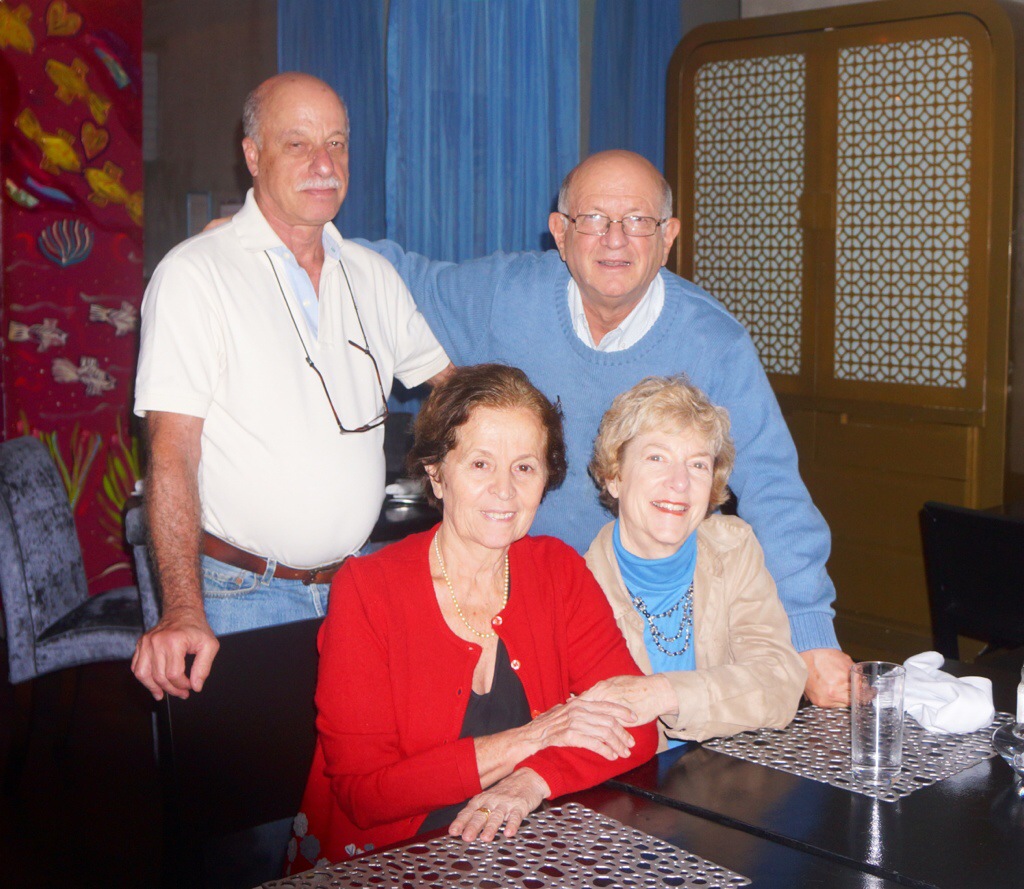
After dinner and two delicious caipirinhas, a typical Brazilian drink that they introduced me to, we taxied back to our guesthouse.
April 27
Excellent breakfast in the hotel before being picked up by Gabriela for a walking tour around the historical old town at 9AM. The Pelourinho is situated in the historical center of Salvador. Declared a world heritage site by UNESCO in 1985, it is a great example of colonial history and symbol of the black movement in Bahia. Pelourinho literally means the pillary where slaves were beaten, pillaried. The Pelourinho contains a number of churches, museums, local artists’ studios, galleries, shops and restaurants.
We had a bit of a zany tour, because it started in drizzle, evolved to a really heavy rain (which caused us and Gabriela to purchase umbrellas) and eventually subsided, after we stopped for coffee. The umbrella business was definitely the business to be in this morning. We ducked into various artist studios, shops and churches, in part to explore them and in part to escape the rain. Because it’s Sunday, many places are not open. A holiday in honor of St. Benedict was being celebrated, with music and processions in the elaborate São Francisco Church and in a Black church named Our Lady of the Something-or-other (not its actual name) and we visited the Cathedral Basílica. As we walked we saw the cobble-stoned, colorful streets of the historic district.
We walked (in pouring rain) to the Elevador Lacerda, built in 1873 and connecting nowadays the Upper City and the Lower City as an important means of transport both for locals and tourists. From there we would have gotten a panoramic view of the All Saints Bay and Mercado Modelo, except that we pretty-much couldn’t see shit (slight exaggeration, blogger’s license).
Gabriela is a fun guide and companion, and her personality engages everyone we encountered.

After we left Gabriela, at noon, we visited a very interesting museum that combined African masks and statuary with a fascinating collection of odd musical instruments made by a Swiss craftsman. We wished we could have understood more (or at least some) about the instruments, but they were most interesting to look at, anyway.
So, there emerged a sort of pleasing kaleidoscope of an experience to our morning, not exactly what we’d optimally have planned, but memorable and enjoyable nonetheless. I hope that the photos below capture something of the scope and nature of that experience.
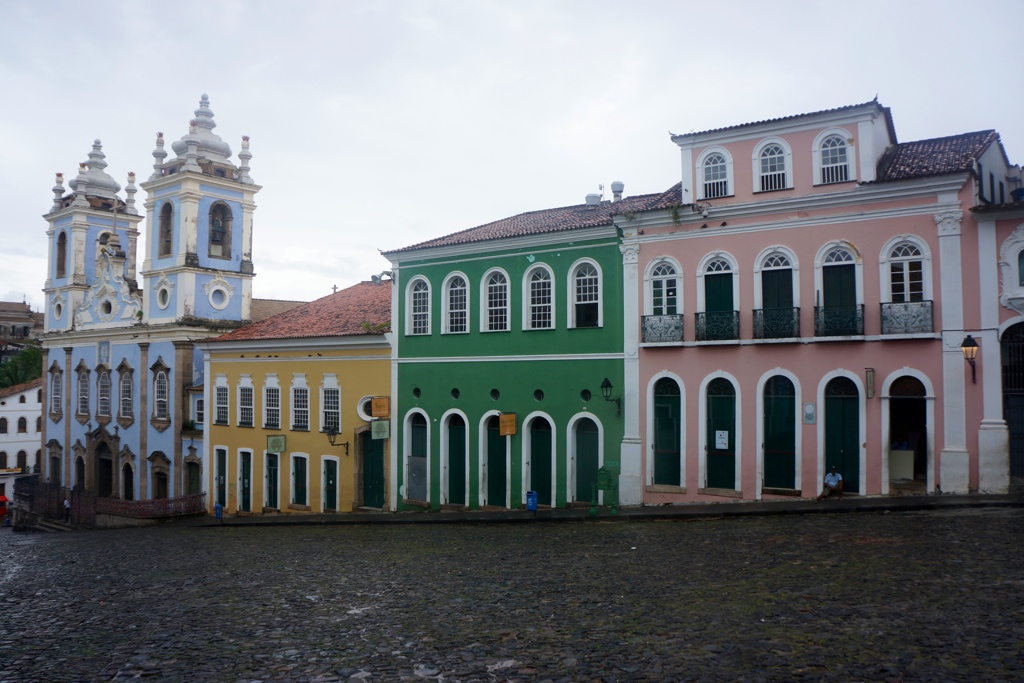
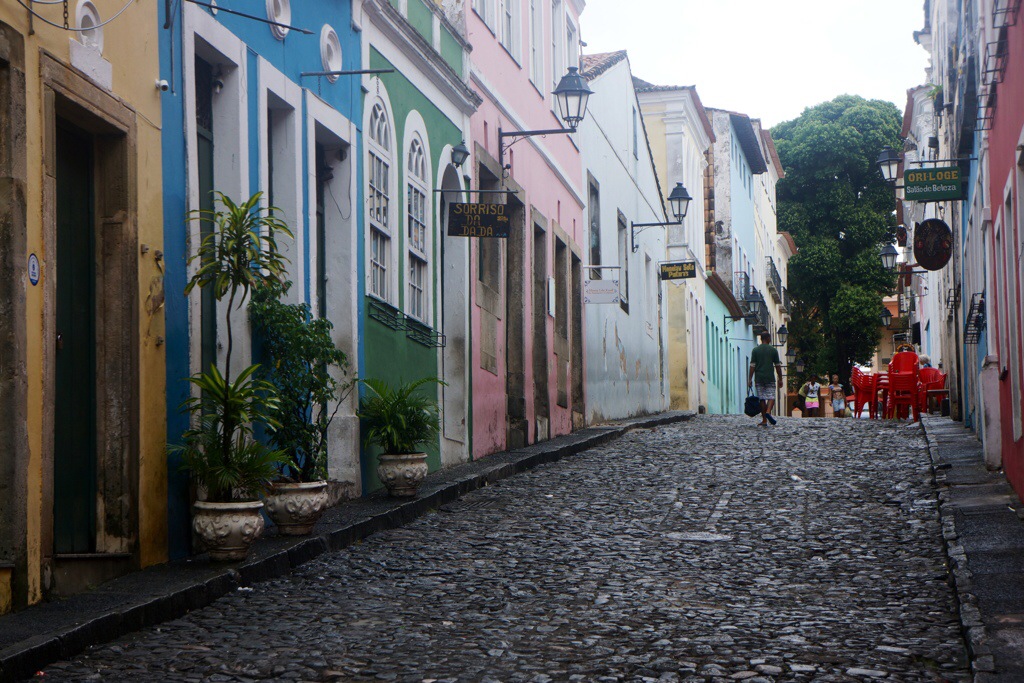
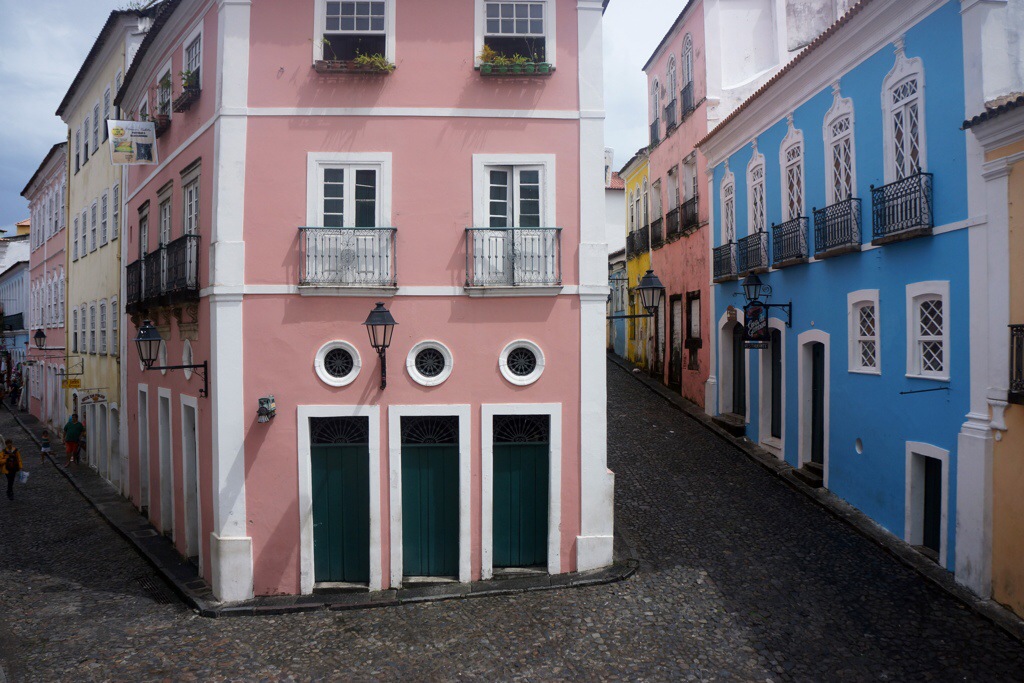
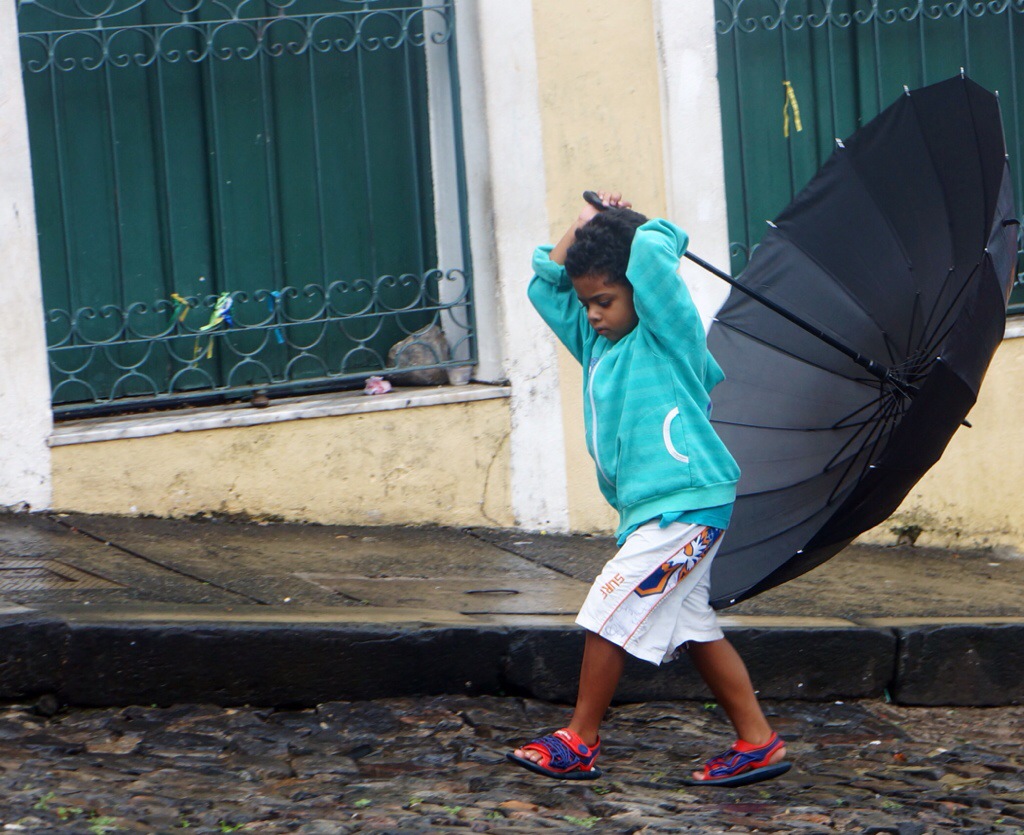
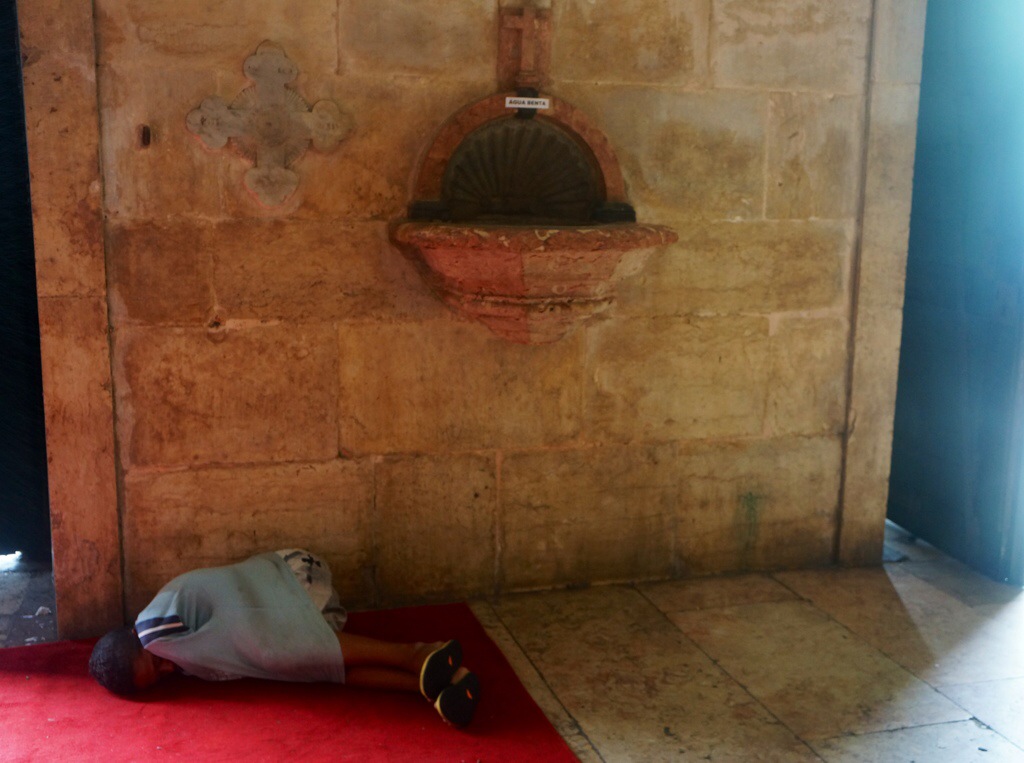
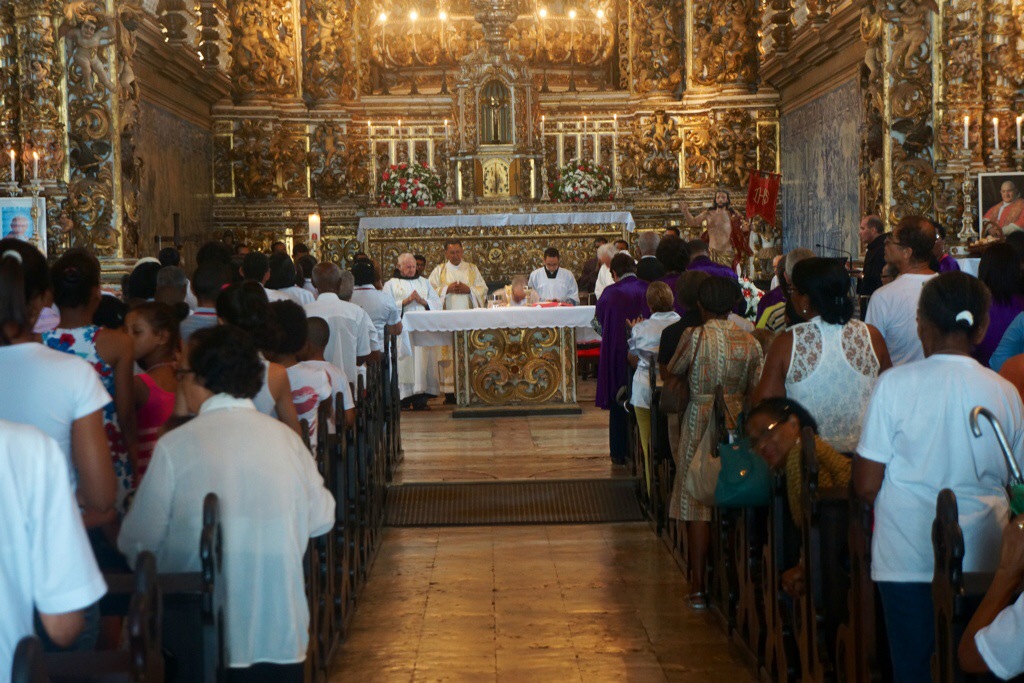
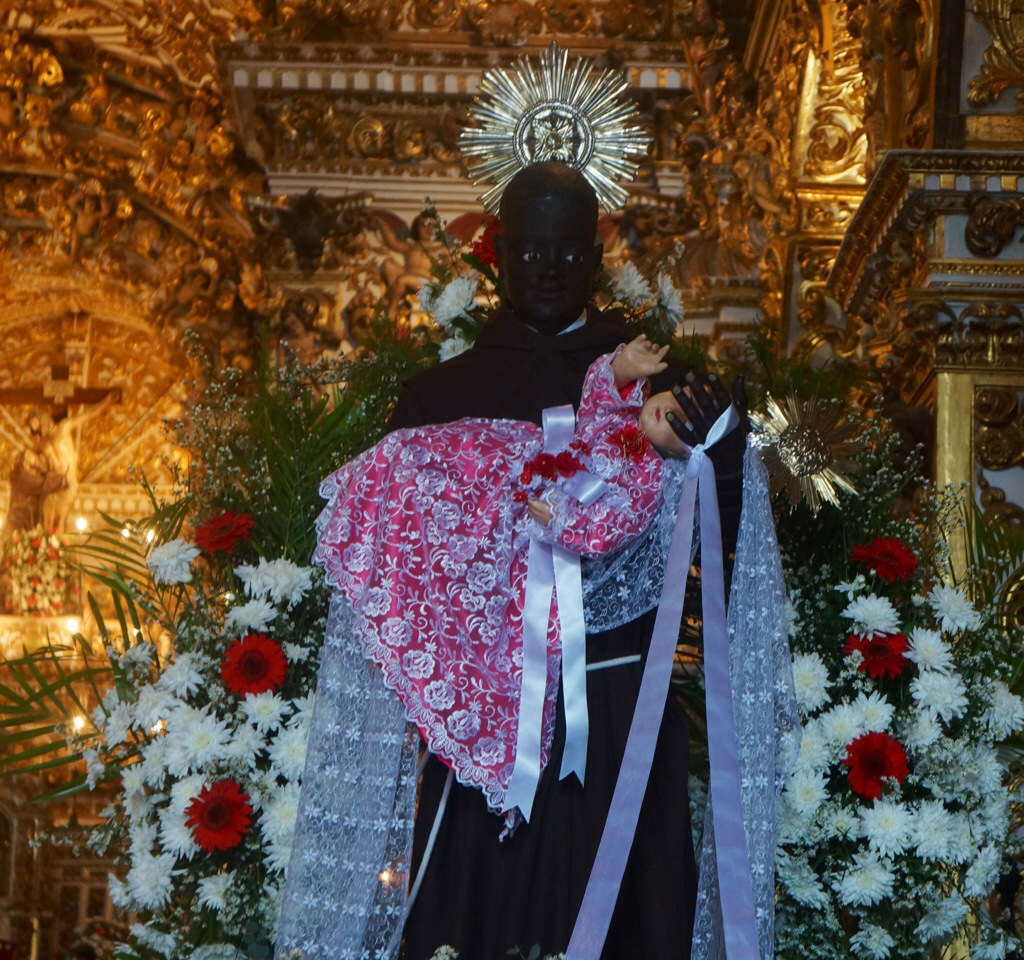
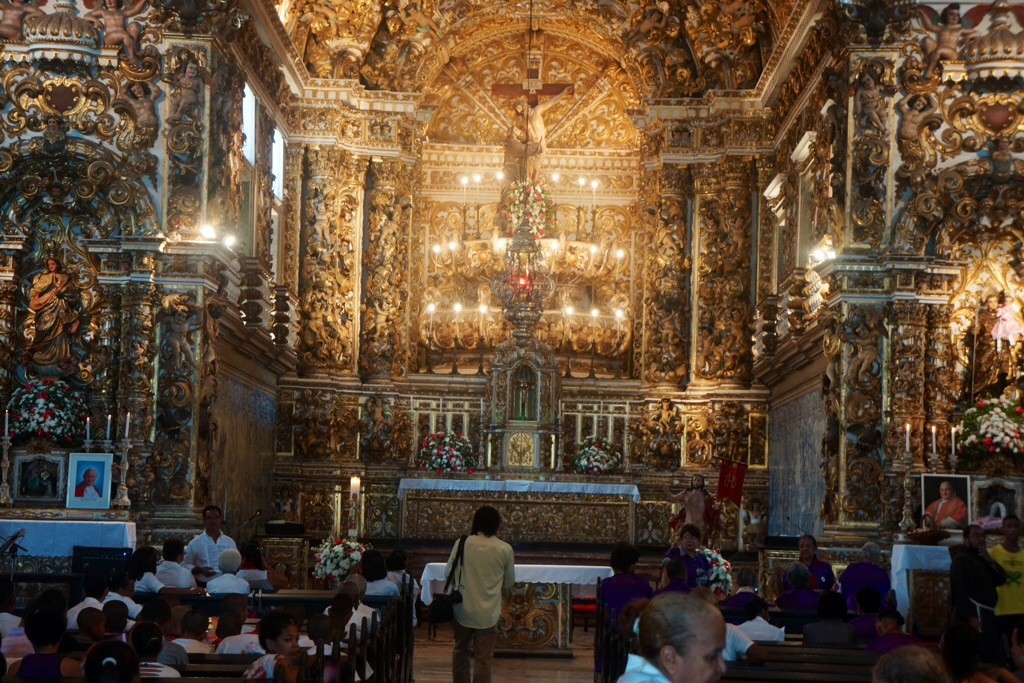
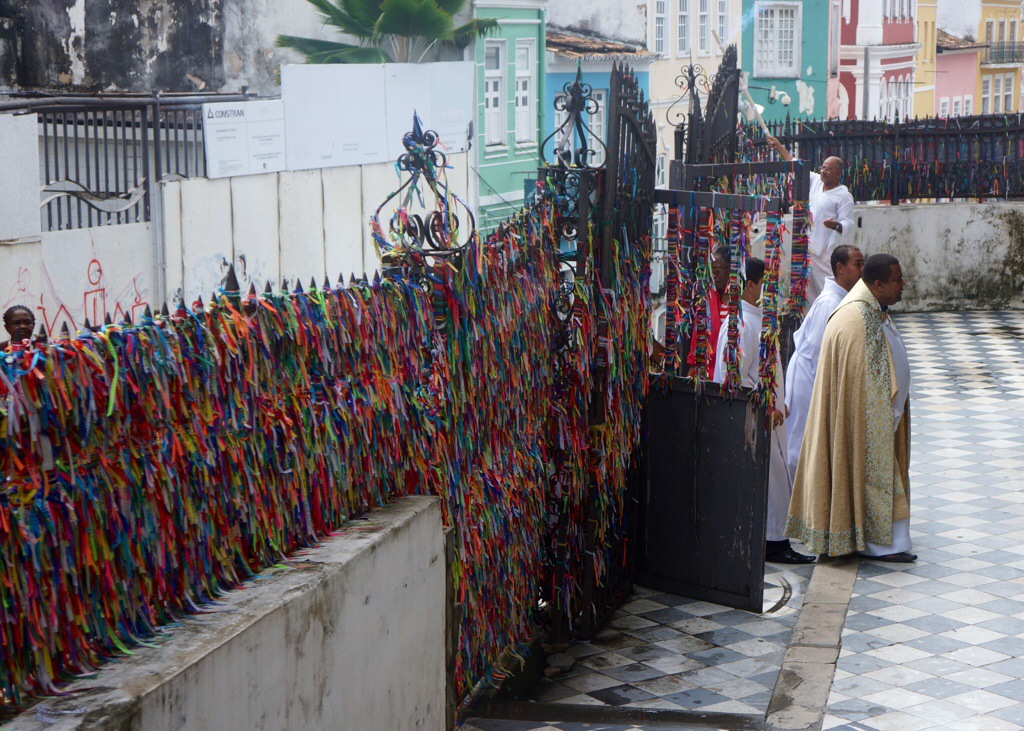
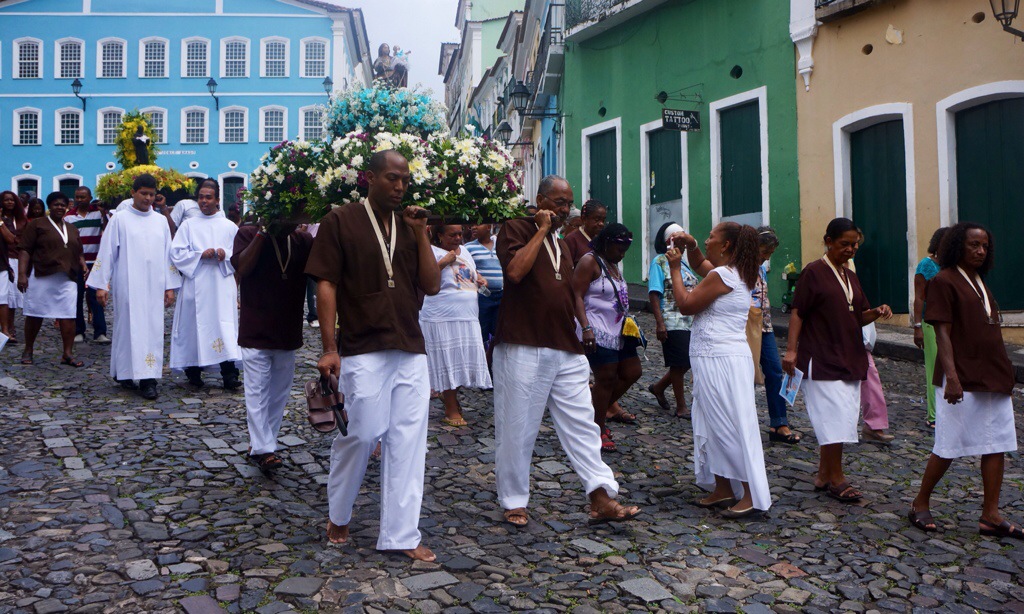
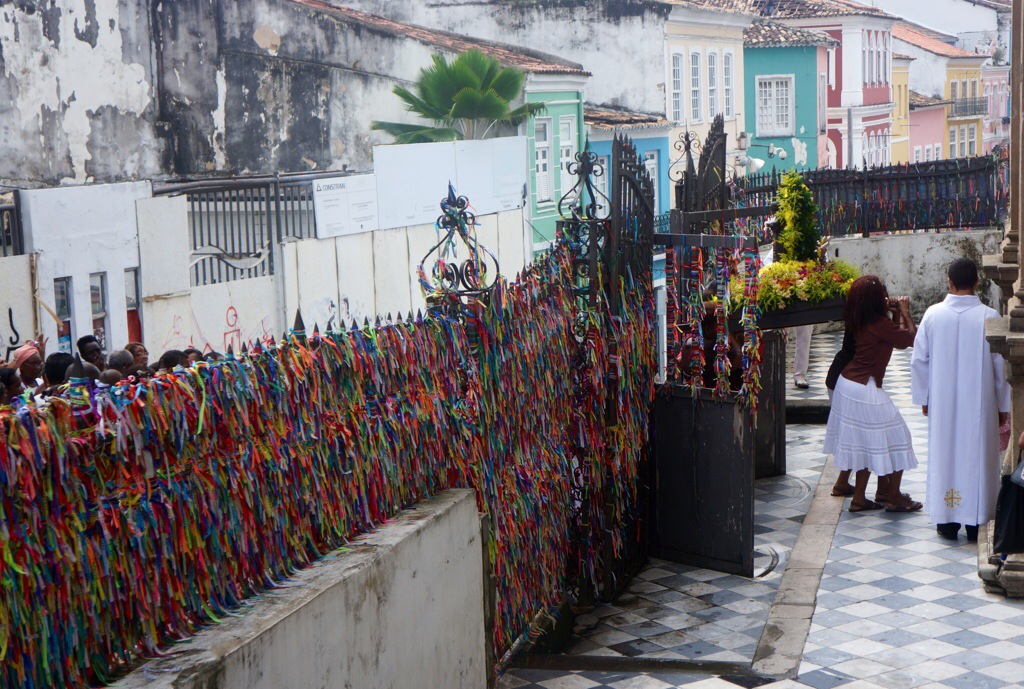
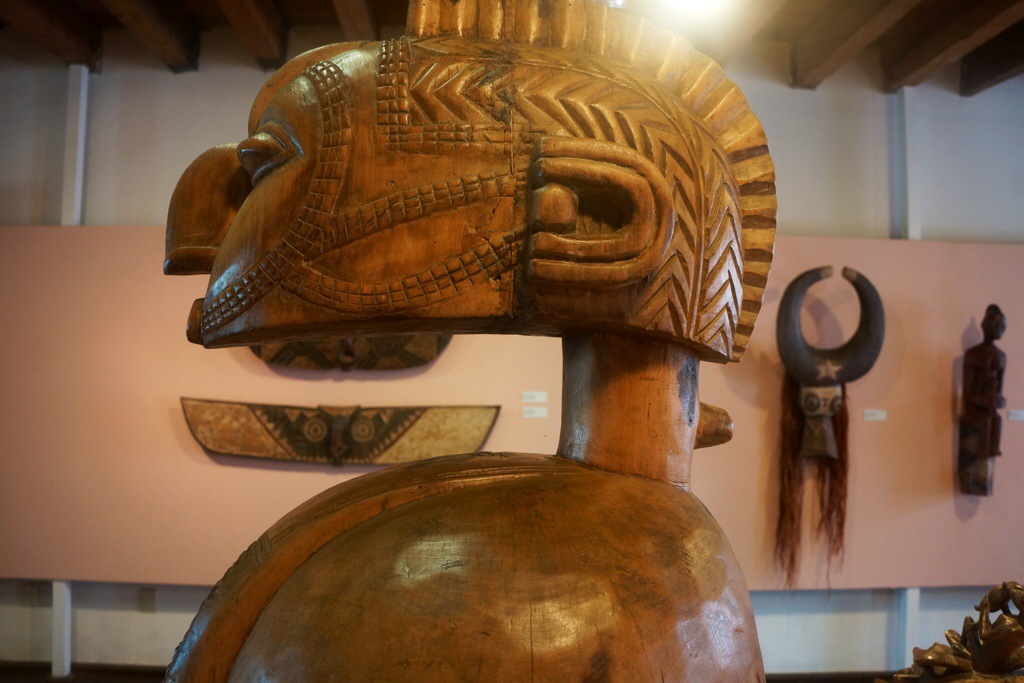
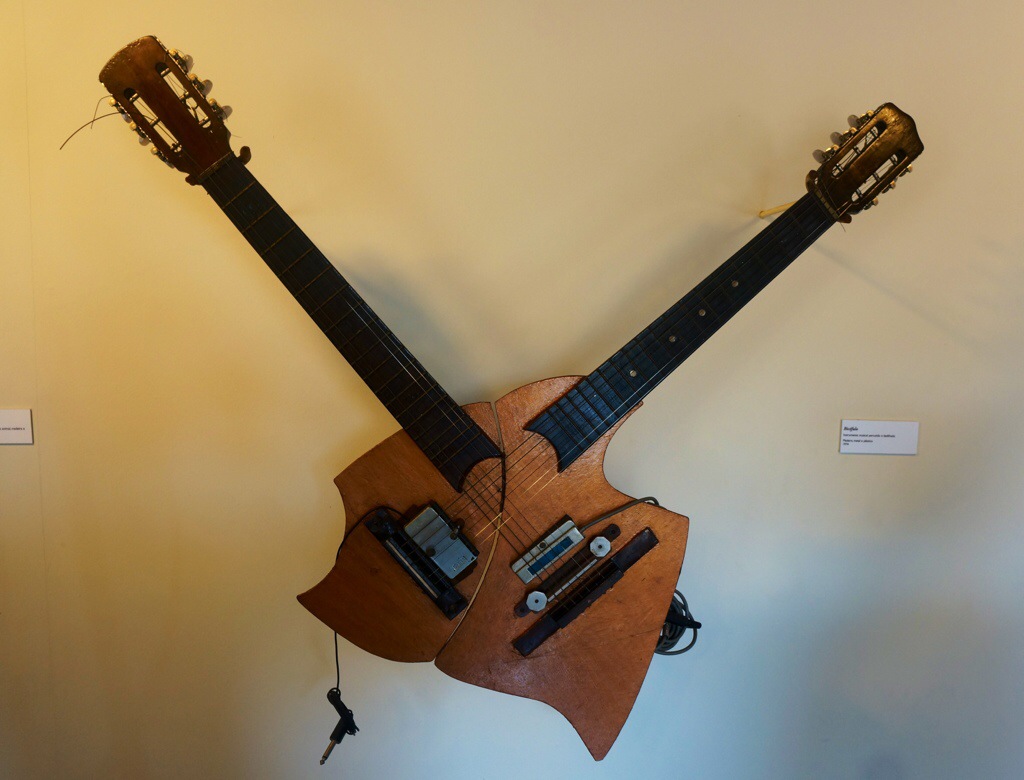
Rodrigo has trouble getting near the hotel, but does eventually, minus Fernanda and Julia, because the latter has a runny nose. We try to park nearby, but nothing is around, so we engage the services of a young boy to lead us to a spot. By the time we get there, Rodrigo decides that this is not such a good idea, but needs the help of the boy to lead us out. Rodrigo gives the boy some money to change, so that he can give him a tip. I can’t believe Rodrigo has done this and, of course, the boy never returns. Rodrigo is philosophical about all this, and we’re now aware that it’s not only tourists who get taken in.
We drive to the Igreja do Senhor do Bonfim church, where a service is in progress. A young woman is tying a ribbon to the fence, like the ribbons at the church we saw this morning.
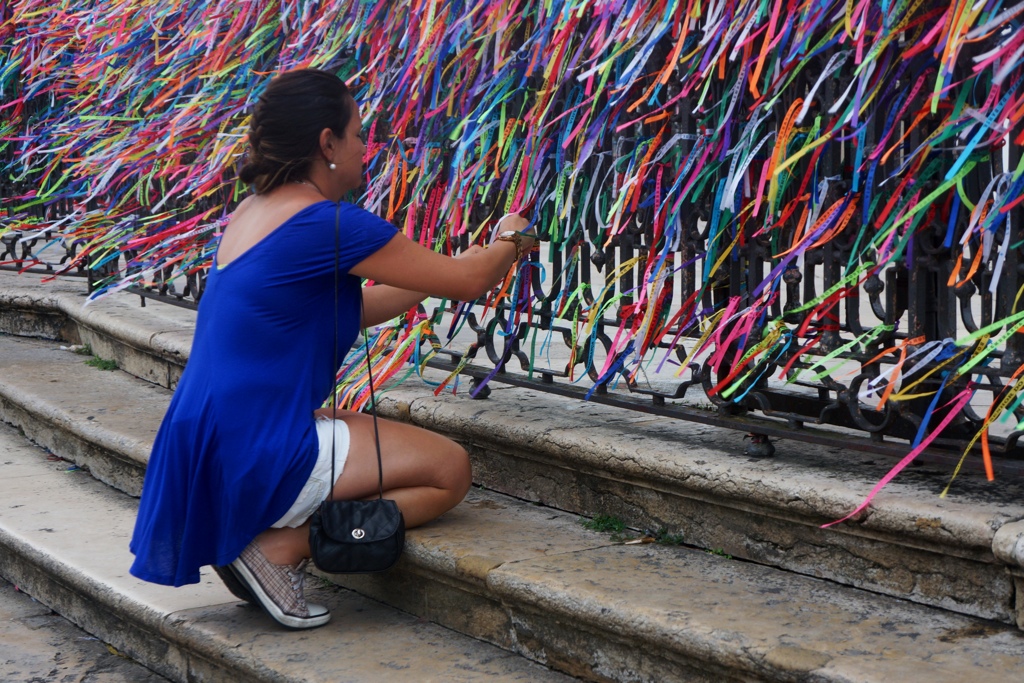
We go into a room that has wax arms, legs and organs hanging from the ceiling, tributes for the healing that people whose pictures and letters of thanks are displayed in another wall of the room.
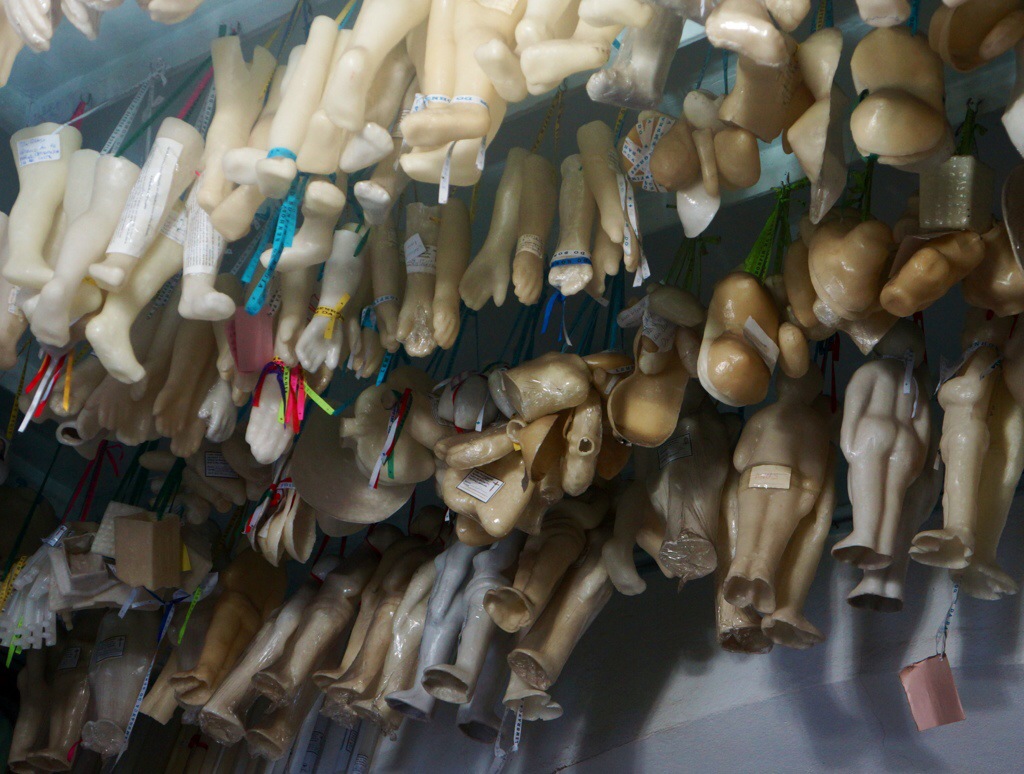
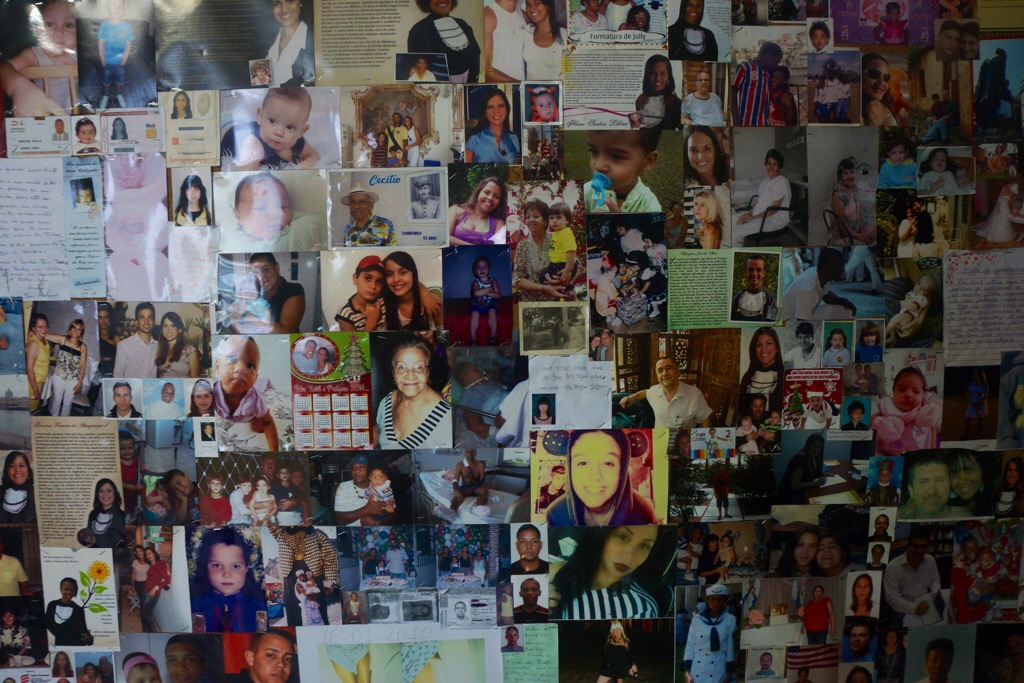
We see the odd instrument that the guy played at the ballet last night, and Rodrigo tells us that it is called a berimbau, and that he knows how to play it. It seems that he studied martial arts for two years, and knows how to do the acrobatic dancing/fighting that the dancers did last night. Those who learn the martial arts are required to learn how to play the berimbau, as it is viewed as part of the same training. So, the things we saw at the ballet last night are starting to make more sense.
From the church, Rodrigo takes us to Sorventeria de Ribeiria, an ice cream place that was founded in 1931. We feel compelled to partake, Carol toasted coconut and me, at Rodrigo’s suggestion, tapioca. After the ice cream, Rodrigo takes us back near our hotels. Our good-byes are not that sad, as we’ve agreed to have dinner in Chicago with Rodrigo and Fernanda when they come for a big oncologists’ meeting late next month. We’ll finally get to meet Julia, but in Chicago, not Brazil.
Carol and I go straight to a restaurant Gabriela has recommended not far from the hotel, called Maria Mauro. It’s quite good, but not as wonderful as last night’s meal.

In the lobby, we chat for over half an hour with a couple from New York, Anne and Charlie, a FDA lawyer. They’ve been to Rio and Iguazu Falls, and then had a fabulous time on the Amazon.
We go up to the room, where Carol packs and I work on this damn blog.
April 26
Returned to the world of the living, after a great night’s sleep. Very good breakfast served to us on a lovely little tiled patio in the hotel. Able to check emails as we await the start of our full day tour with Gabriela, which starts at 8 AM.
To circle back to yesterday, the ride from the airport is along a highway appropriate to a city of Salvador’s size, over 3 million. As we arrived midday, traffic was not horrendous, though Gabriela says that it is in rush hour. Very poor areas are mixed with new, modern buildings.
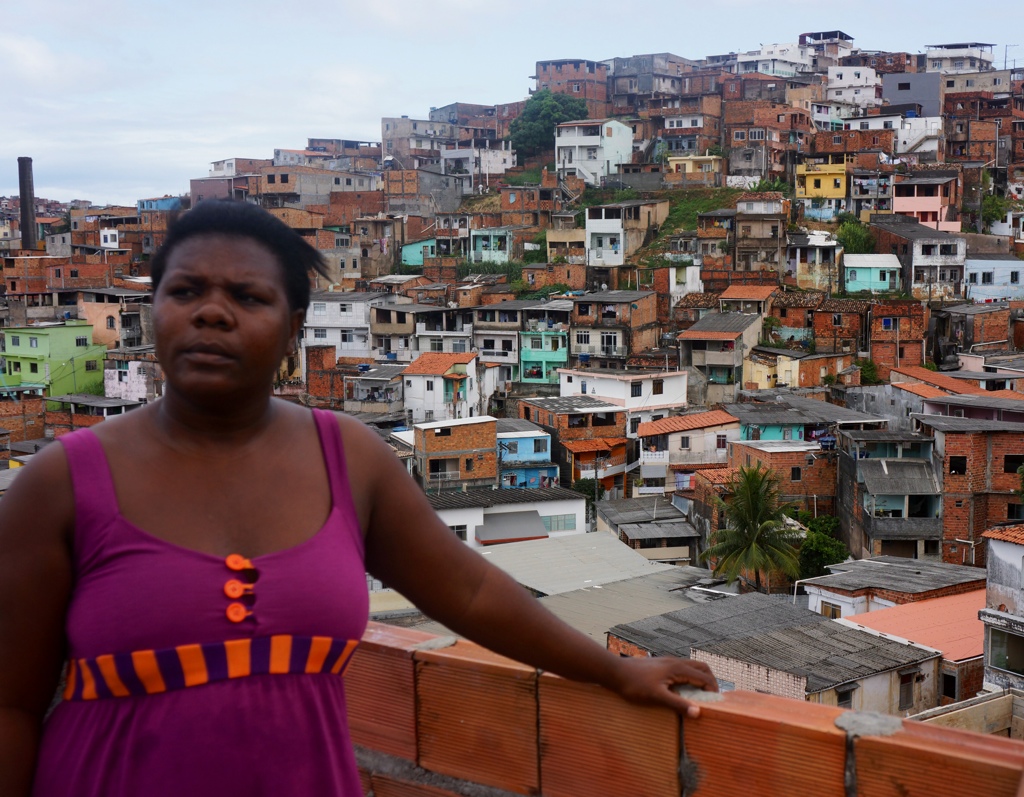
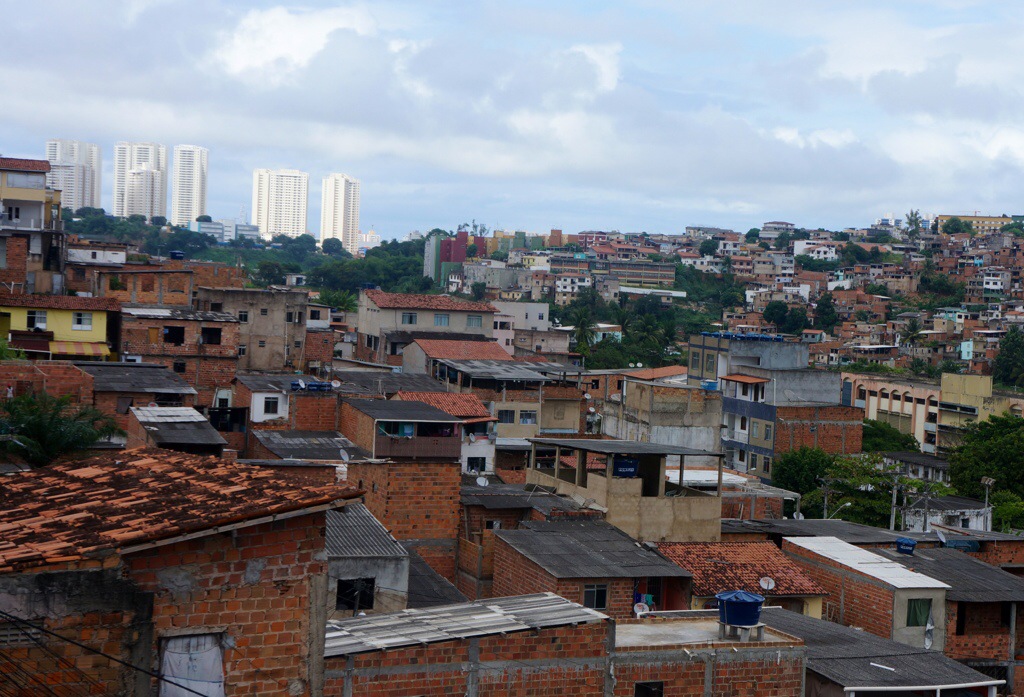
The transportation system languishes because of poor government supervision and corruption. The train extends for only 131/2 kilometers.
Last night’s dinner was ordered for us by Rodrigo and Fernanda, and consisted of traditional dishes of octopus and shrimp, called moqueca, served in two very large boiling pots of Palm oil and eaten with rice and a flour-like powder. We’d had crab appetizers, as they were delayed because their baby sitter for Julia was late.
Sorry for the diversion, now back to today. Our first and most interesting stop of the day was to see and get to know a serious social action project, Mujeres de Calafate, which works for positive results for those living in a social risk area. Situated in one of Salvador´s favelas (shanty towns), the project was started in 1992. It deals primarily with issues relating to protection of abused women and use of condoms. It’s members engage in various entrepreneurial projects to raise funds. We spent two and a half hours talking to three generations of women, starting with the 80-year old grandmother in whose house the operation is centered and including five adorable granddaughters around the age of 10, who both greeted us and, at the end, showed us off with hugs. They will be the next generation to carry on the work of the project. Our main contact was with a 24-year old, who looked about 15 and had a child two years ago. Gabriela, our guide, was fascinated with the group and served ably as our translator. We walked all around the hilly area with project members, including the young girls.
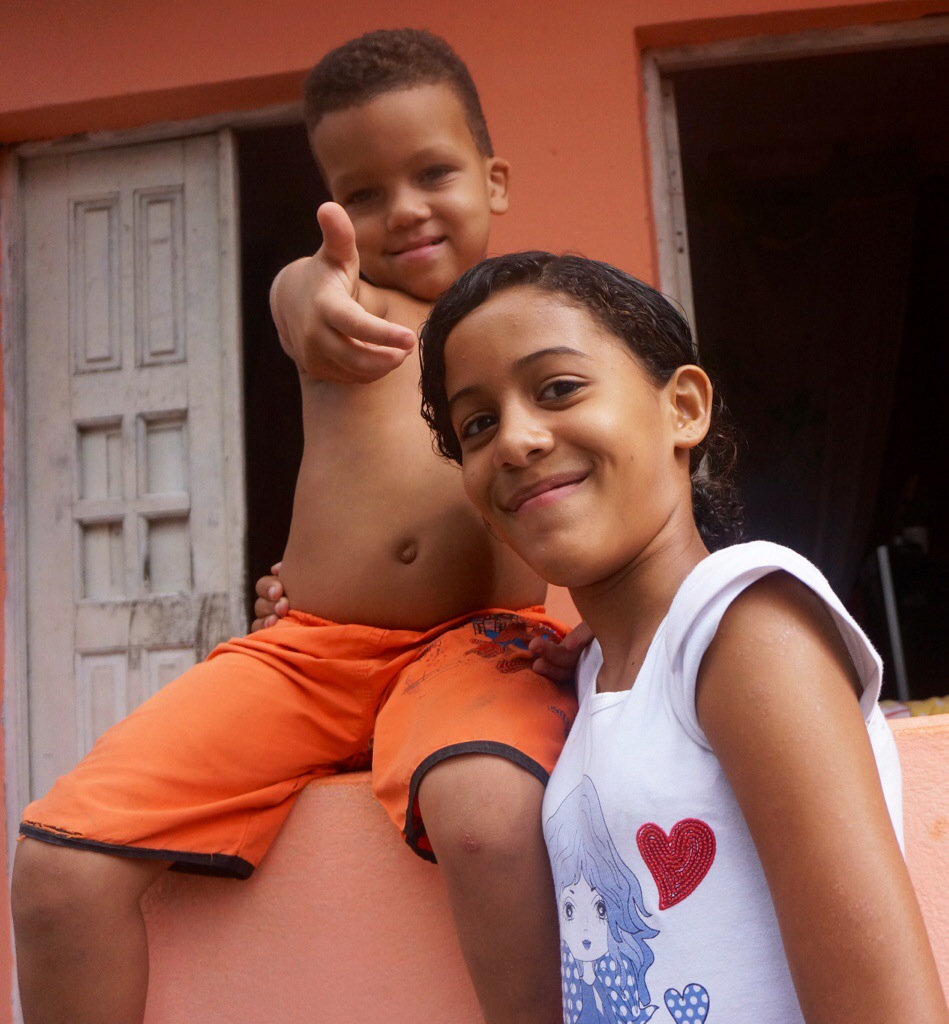
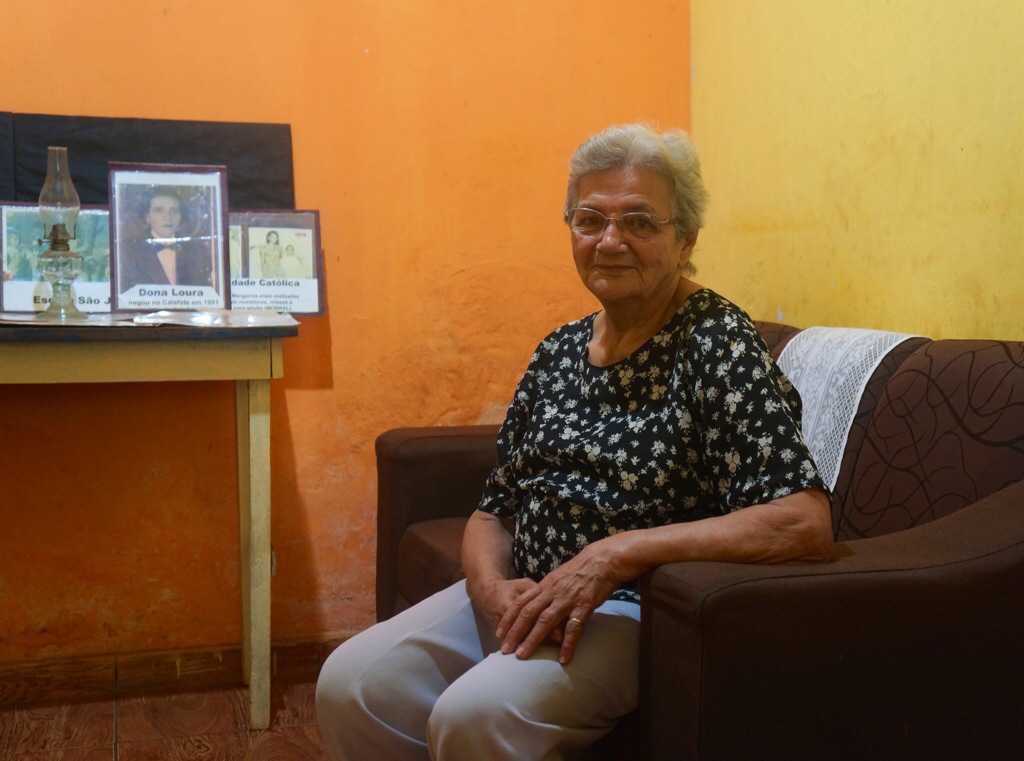

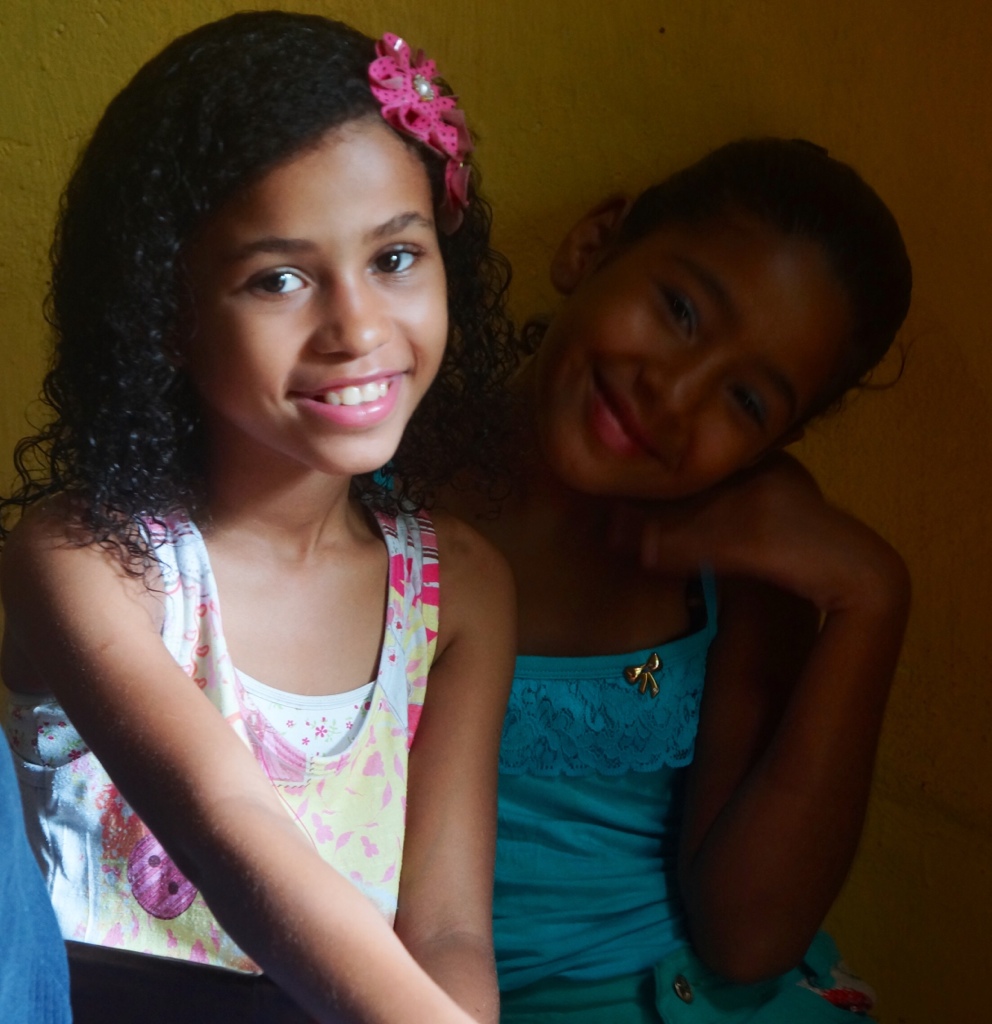
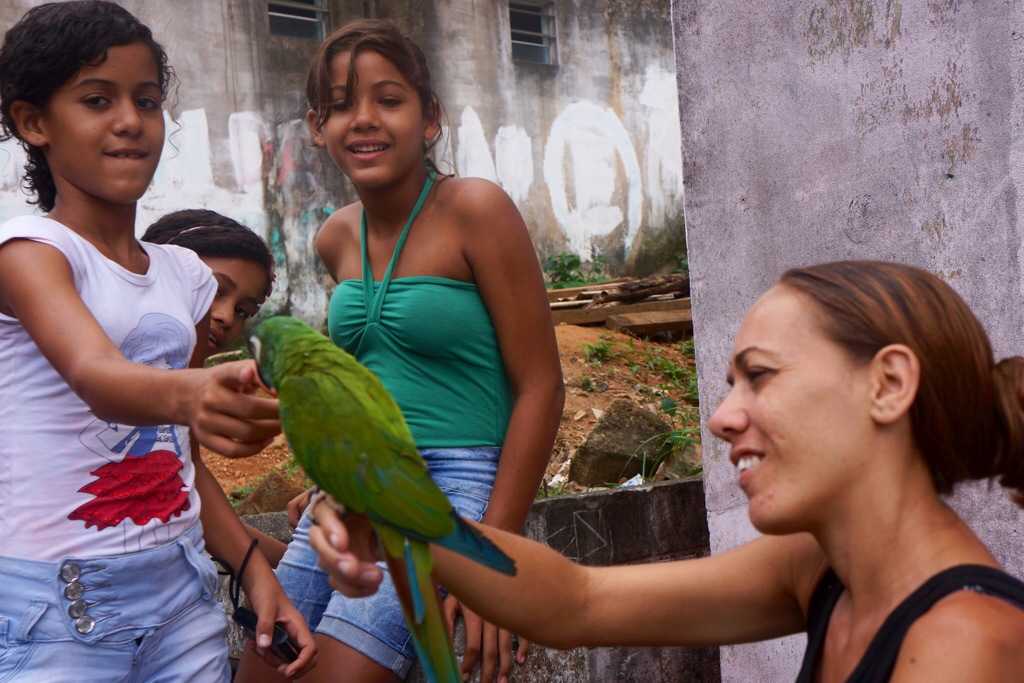
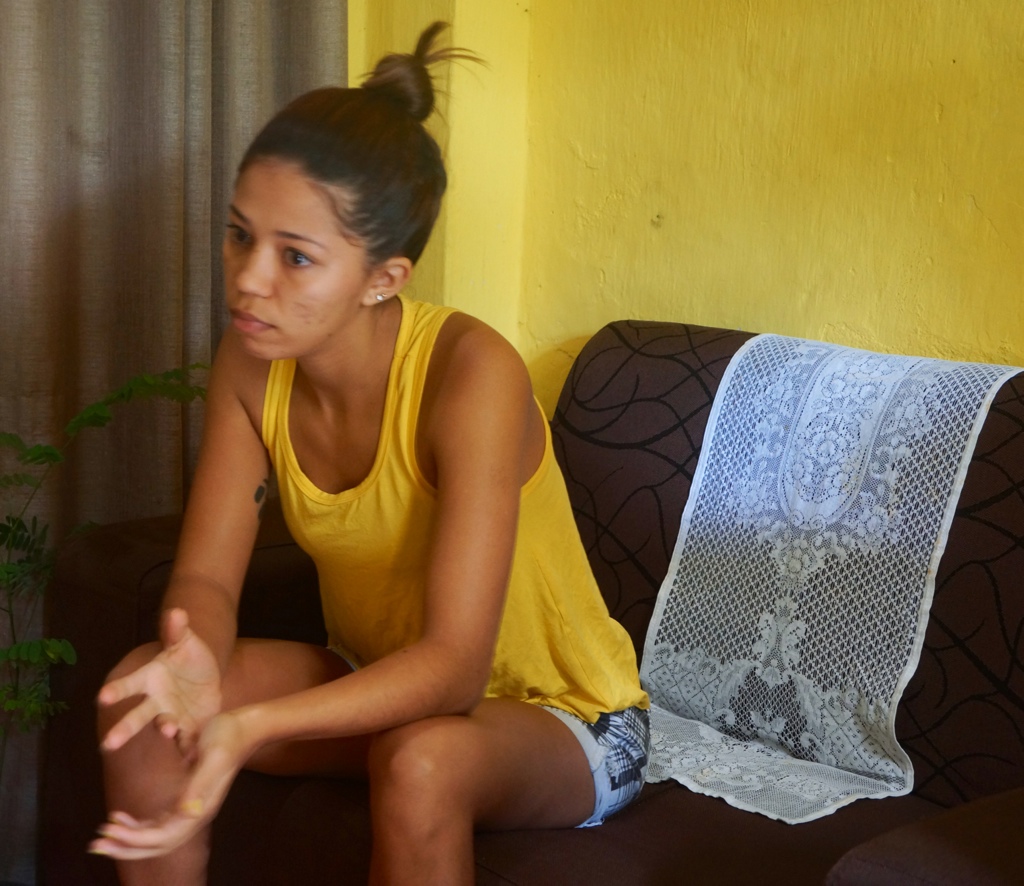
As we left the project people, Carol and I noticed a Seventh Day Adventist service in a sort of storefront setting. We wandered in and were received very warmly, with people giving us their seats and handing us prayer books and pointing to the place we were at in the service from time to time. We stayed about 15 minutes or so.
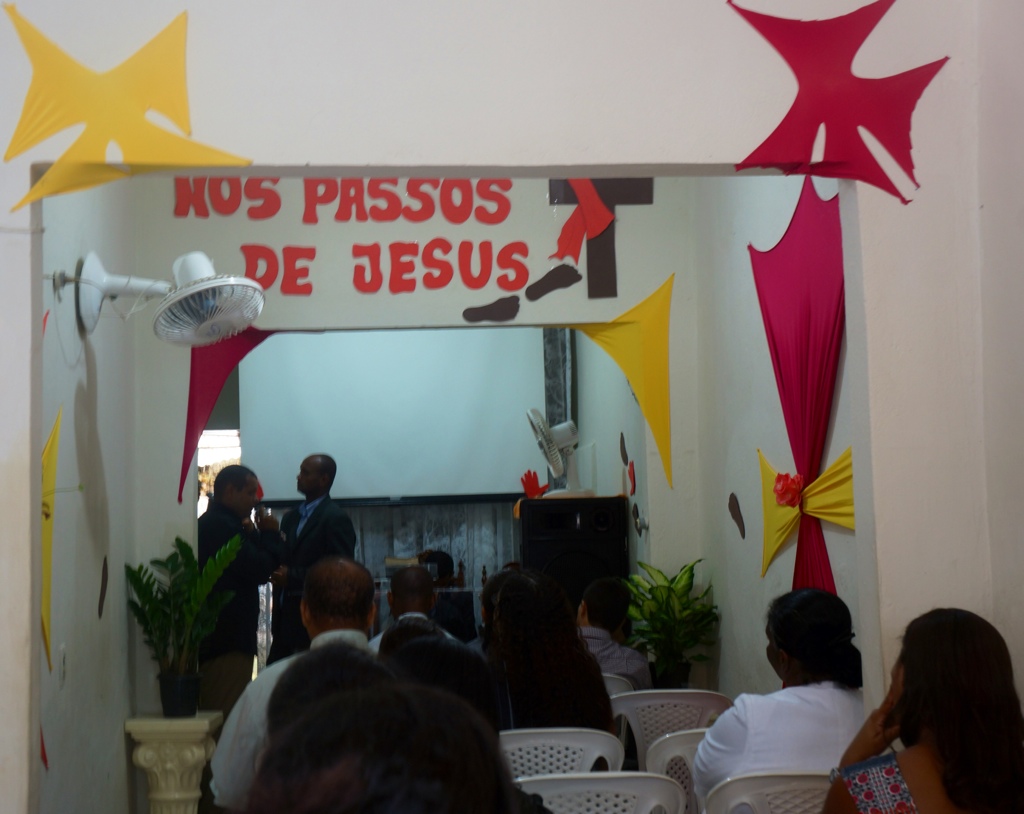
Next we went to a Cantambole area, where a religion that combines African gods with Catholicism is practiced. This is akin to the Santeria religion I’d seen in Cuba. I was very interested in this, and Gabriela was knowledgable and able to talk about it as we walked around the area and looked at the outside of the temple buildings. Unfortunately everything was closed up and there were no services being held, because of proximity to Lent. This was not Gabriela’s fault, but was very disappointing to me. On top of it, no photos were allowed. Bummer.
We were driven down to the port, for a brief stop to see some fishermen and a chapel to the mermaid goddess. From there we went to a little restaurant where we had small (meaning huge) sorbets, Carol mango and me and Gabriela, banana. They were delicious, filling and the cold really hit the spot. I had changed some money with Gabriela, rather than look for a bank. Her rate was considerably better than at the airport, because no fees were involved.
We went down to the very large marketplace and walked around for an hour. Gabriela explained what everything (vegetables, fruit, meat and other goods) was, and, telling us that the prices were less than half of what she generally pays, proceeded to buy eggs, nuts and something else. She is 47 years old, married to a 57-year old police officer and has a 17-year old son. She is zippy, open and fun. While the market was interesting enough, at this point carol and I have seen so many markets around the world that it was not new.
We stopped to buy tickets for a ballet folklorico performance tonight (after switching our plans with Rodrigo and Fernanda to tomorrow afternoon, since they could not find a baby sitter for Julia). I noticed a sign that seemed to me to suggest that there were discounts for old farts like us. Gabriela asked. Fifty percent off. Yes! It occasionally pays to be old. We walked around the area near our hotel a bit, trying unsuccessfully to get money from a bank ATM, and then Gabriela walked us back to our hotel, where we rested before our evening activities. Not to ruin the suspense, but the evening started out really good, and ended up really not so good at all.
After having our complimentary drinks at our hotel, we walked to a restaurant recommended by Gabriela a few blocks away in the Hotel Villa Bahia. There we had a terrific dinner in a little patio area. I had the sea bass over black rice with a coconut crust and vegetables. Carol had a mushroom and vegetable ragout over palenta. Excellent.
We taxied to the Teatro Castro Alves for the Ballet Folklorico, arriving almost an hour early. The performance was quite spectacular and some of the elements were memorable, including the opening in which the entire cast marched down the aisles singing, a guy who played a really weird and interesting sounding instrument, some incredible drumming and some very acrobatic male dancers. The program could definitely have benefited from some judicious trimming, but it was overall well worth seeing.
Taxied back to the hotel area where, walking down the street a young guy ripped a thin gold chain off of Carol’s neck and ran off. She was unhurt, but upset at having lost the necklace she’d had for forty years. We’d been warned about this, and Carol had been told not to wear necklaces, but still…I guess at least we can say that we had an authentic Brazilian experience. Worse than losing the necklace, Carol lost the seat she uses to help her back, apparently having left it in the taxi. The guy at our hotel called the taxi company to report it, so perhaps the driver will find and return it. But that seems rather unlikely. So, a lousy end to the day.
April 24-25
Spent the day packing and getting ready (okay, piddling around) for our 9:30 PM departure, a non-stop flight to Sao Paolo, more than 10 hours and over 5000 miles away, where we’ll have a layover of about 3 hours before continuing on to Salvador de Bahia, a flight of a bit over two hours. Yes, it’s a pretty long haul, but we’re rather used to it, and have done considerably longer. Truth is, it would be a really long walk, so it’s best to just suck it up and get on with it.
The airport experience was pretty-much the airport experience. There was some unexplained trouble in getting our boarding passes. Carol was randomly selected for the fast security line; I was not.
Yesterday I’d had lunch with a friend who had been to Brazil four times, and cautioned me strongly about the dangers of travel there, advising me to get a money belt to wear. Really, I asked. Really. I’d told Carol, so, as she got through the security line first, she found a store that sold money belts and had one put aside for me. At the counter, I asked one of the two young male employees whether the belt was worn under the pants. When they said it was, Carol asked whether I’d be able to close my pants. If not, I told her, you’ll hold them up. One of the two guys immediately asked how long we’d been married. I said that, if we make it to June, it will be forty-nine years. They were amazed, smiled and congratulated us. We’re amazed, too. Money belt purchased, but not yet donned (I’ll have $21 less to store in the belt), we headed to the United Club, where I overloaded with crap, before it was time to board our flight.
Now’s the time you regret not having read more about where you’re going and how, despite your vow to do better, you’ve once again put more in your suitcase than you need. This reminds me of a story that a very bright young woman investment banker told me about her interview experience. As a consultant, I was talking to some prize hires of my premier investment banking client so as to be able to give them advice about recruiting. The woman told me that she was asked repeatedly by bankers what her worst characteristic was. Evidently bankers thought this was a clever question and that they were the only ones who used it. Most interviewees answered by sneaking in a positive trait as their worst characteristic, for example, “I’m a perfectionist and can never settle for less than the best” or “I sometimes drive myself too hard to accomplish my goals.” Anyway, this woman said that she got so sick of it that she began to answer the question of what was her worst characteristic by saying, “I over-pack.” I’d have hired her on the spot.
But I digress….We are traveling Economy Plus, which is roomier than coach, but much less expensive than Business Class, a sort of compromise. Announcements are in English and Portuguese, a language I’ve not heard before, a kind of cross between Spanish and French. I can pick out a (very) few words with my Spanish. Luckily, though, I’m fluent in English. I’ll use my ten hours of flight to read some short stories by Native American author Sherman Alexie, which Carol and I are reading for our book group, review a book I bought on the operation of my camera, waste time on Sodukos and try, but fail, to sleep. All of my reading is on my iPad, as I’ve totally crossed over to the dark side. Oh, yes, and write in the blog. For instance, now I’ll give you some information on where we’re headed, Salvador de Bahia.
As the first capital of Brazil, from 1549 to 1763, Salvador de Bahia witnessed the blending of European, African and Amerindian cultures. It was also, from 1558, the first slave market in the New World, with slaves arriving to work on the sugar plantations. The city has managed to preserve many outstanding Renaissance buildings. A special feature of the old town are the brightly colored houses, often decorated with fine stucco-work. As the first capital of Brazil, from 1549 to 1763, Salvador de Bahia witnessed the blending of European, African and Amerindian cultures. It was also, from 1558, the first slave market in the New World, with slaves arriving to work on the sugar plantations.
As early as 1549, the Governor General, Thome de Souza, on the orders of João II of Portugal, made Salvador the seat of the royal administration. It played a leading economic and political role until 1763, when the seat of administration was transferred to Rio de Janeiro. The upper city, located in the area of Bahia de Todos los Santos, was discovered in 1502 by Amerigo Vespucci, and has been preserved by its historical evolution. It was built upon a ridge parallel to the Atlantic coast, which made possible defense against Spanish (1580) and Dutch (1624) attacks.
.
The historical centre itself, which revolves around the Pelourinho quarter with its triangular place, is characterized by its fidelity to the 16th-century plan, the density of its monuments, and the homogeneity of its construction on a hilly and picturesque site which embellishes the urban scenery by providing steeply falling and ascending views of incomparable beauty.
For those who may be interested, here is a very brief (and not very pretty) history of slavery in Brazil:
The slave trade
Initially the Portuguese seemed to hit it off with Brazil’s natives. There was even an exchange of presents between Cabral’s men and the Indians on the beach, with a Portuguese sombrero swapped for feather headdresses. Relations cooled when the Portuguese started enslaving their neighbors for work on the sugarcane plantations. Yet, for a variety of reasons the Portuguese felt the Indians didn’t make great slaves and turned instead to Africa’s already existing slave trade.
African slaves started to pour into Brazil’s slave markets from about 1550. They were torn from a variety of tribes in Angola, Mozambique and Guiné, as well as the Sudan and Congo. Whatever their origins and cultures, their destinations were identical: slave markets such as Salvador’s Pelourinho or Belém’s Mercado Ver-o-Peso. By the time slavery was abolished in Brazil in 1888, around 3.6 million Africans had been shipped to Brazil – nearly 40% of the total that came to the New World.
Africans were seen as better workers and less susceptible to the European diseases that had proved the undoing of so many Indians. In short, they were a better investment. Yet the Portuguese didn’t go out of their way to protect this investment. Slaves were brought to Brazil in subhuman conditions: taken from their families and packed into squalid ships for the month-long journey to Brazil.
Visitors to the beaches of Porto de Galinhas, near Recife, might not pick up on the area’s grim past. Even after abolition, slave traders continued to smuggle in slaves often packed into a ship’s hull under crates full of galinhas (chickens).
Masters & slaves
For those who survived such ordeals, arrival in Brazil meant only continued suffering. A slave’s existence was one of brutality and humiliation. Kind masters were the exception, not the rule, and labor on the plantations was relentless. In temperatures that often exceeded 30°C (86°F), slaves were required to work as many as 17 hours each day, before retiring to the squalid senzala (slave quarters), and with as many as 200 slaves packed into each dwelling, hygiene was a concept as remote as the distant coasts of Africa. Dysentery, typhus, yellow fever, malaria, tuberculosis and scurvy were rife; malnutrition a fact of life. Syphilis also plagued a slave population sexually exploited by its masters.
Sexual relations between masters and slaves were so common that a large mixed-race population soon emerged. Off the plantations there was a shortage of white women, so many poorer white settlers lived with black or Indian women. Brazil was already famous for its sexual permissiveness by the beginning of the 18th century.
Aside from the senzala, the other main institution of the sugar plantation was the casa grande (‘big house’) – the luxurious mansion from which the masters would control their slaves.
Resistance & the Quilombos
Resistance to slavery took many forms. Documents of the period refer to the desperation of the slaves who starved themselves to death, killed their babies or fled. Sabotage and theft were frequent, as were work slowdowns, stoppages and revolts.
Other slaves sought solace in African religion and culture. The mix of Catholicism (made compulsory by slave masters) and African traditions spawned a syncretic religion on the sugar plantations, known today as Candomblé. The slaves masked illegal customs with a facade of Catholic saints and rituals. The martial art capoeira also grew out of the slave communities.
Many slaves escaped from their masters to form quilombos, communities of runaway slaves that quickly spread across the countryside. The most famous, the Republic of Palmares, which survived through much of the 17th century, was home to some 20, 000 people. Palmares was a network of quilombos covering a broad tract of lush tropical forest straddling the border of Alagoas and Pernambuco states. Under their leaders Ganga Zumba and his son-in-law Zumbi, its citizens became pioneers of guerrilla warfare, repeatedly fending off Portuguese attacks between 1654 and 1695. Eventually Palmares fell to a force of bandeirantes from São Paulo.
As abolitionist sentiment grew in the 19th century, many (unsuccessful) slave rebellions were staged, the quilombos received more support and ever-greater numbers of slaves fled the plantations. Only abolition itself, in 1888, stopped the growth of quilombos. Over 700 villages that started as quilombos remain today. Some were so isolated that they remained completely out of contact with white Brazilians until the last couple of decades.
In San Paolo, we collect our bags and, of course, run into a fellow we know who is in our congregation in Evanston. He’s in San Paolo for business for a couple days. We recheck our bags to Salvador, change money and have time for a drink and ice cream. We’re able to get wifi and so check our email.
Trip to Salvador is uneventful, and we meet our guide, Gabriela outside baggage claim. She is a live wire, originally from Buenos Aires, and we ride with her in the air conditioned comfort of our car some 40 minutes to our hotel, which is in the heart of the cobble-stoned historic district. Quaint hotel, Casa de Amarelindo, with a very comfortable room on the third floor, which hereafter I plan to take the slow elevator to reach. We forego a walk around the cobblestones and colorful historic district to rest up AND SHOWER, before dinner.
We take about a half hour taxi ride to the authentic, local restaurant called Restaurante Yemanja, where we meet Rodrigo and Fernanda, two delightful and lovely 30-year old doctors with whom we’ve been put in touch by the Olopades, our Nigerian doctor friends at the University of Chicago, with whom we’ve traveled to Ghana and Nigeria. Rodrigo is an oncologist, who spent two months at the U of C, and Fernanda is a radiologist who spent the time in Chicago at Northwestern. We learn all about their families, including their 4-month old daughter, Julie. They could not be more delightful dinner companions and, before they drive us home, we make plans to get together tomorrow night. Below is a photo of them, and of Carol, checking emails.
It’s about 11PM, and we plan to crash, hoping to be ourselves (whatever that means) tomorrow. Then we begin the real trip, and, hopefully, photographs.
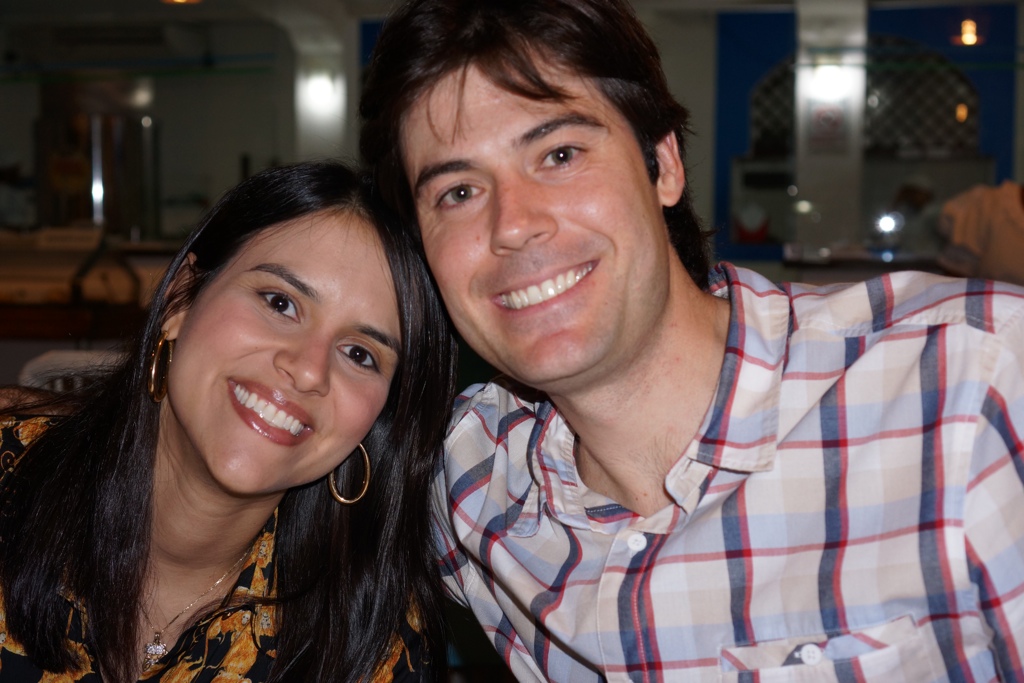
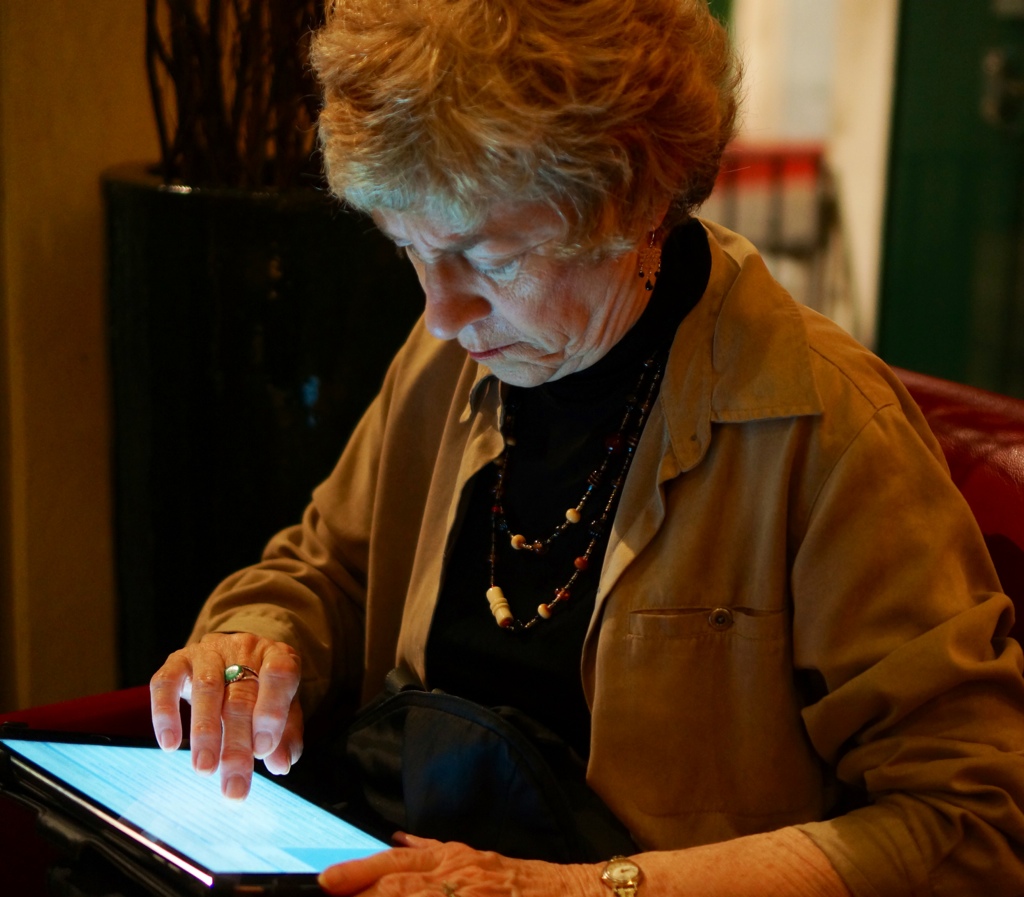
|
|













































